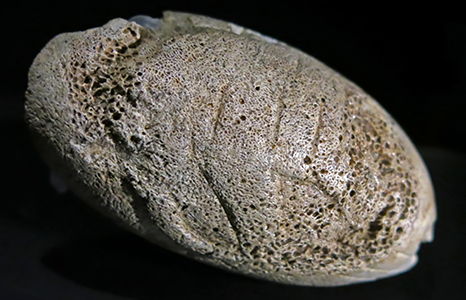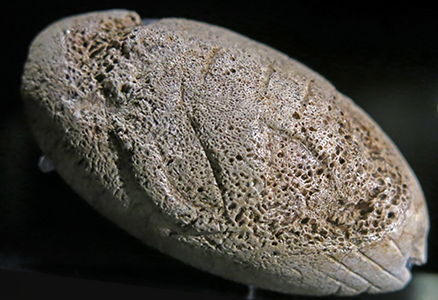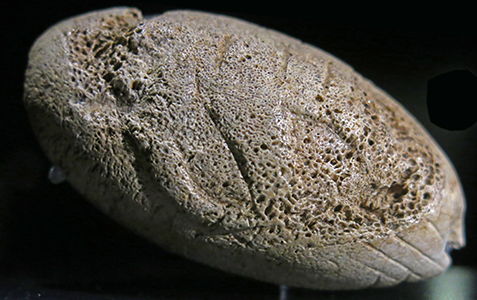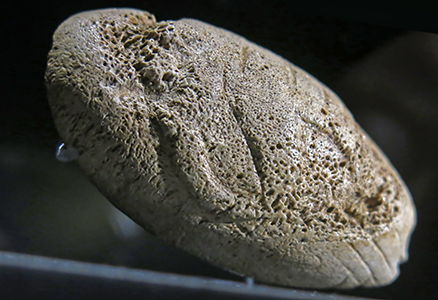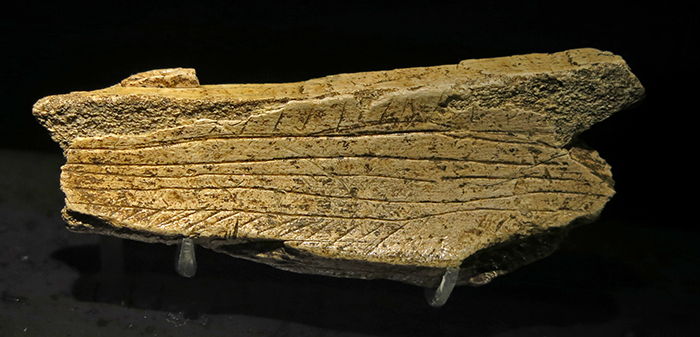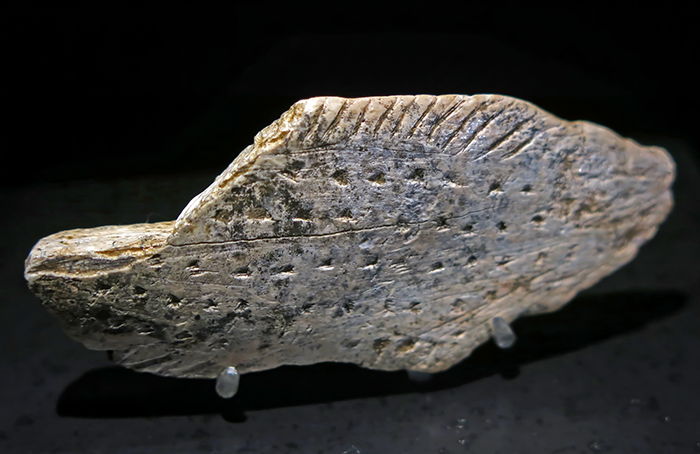Back to Don's Maps
Back to Venus figures from the Stone Age
Vogelherd Cave, Vogelherdhöhlen
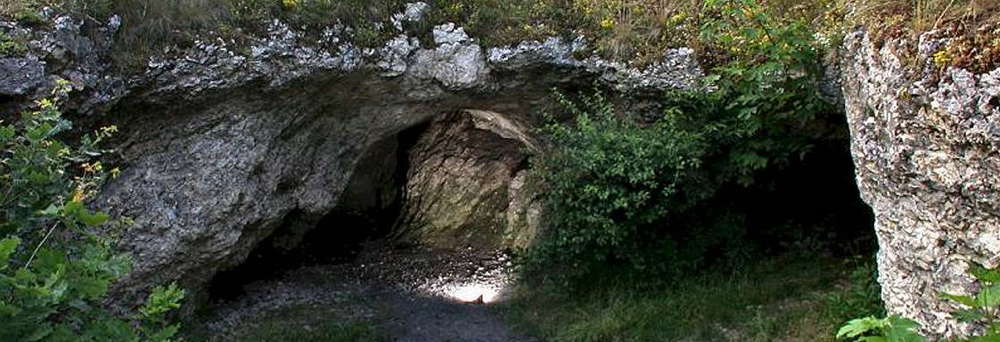
Listed as the Southern entrance, the left cave entrance is the big Vogelherd Cave. The right cave is just a small shelter, cut off from the main passage by a roof collapse many years ago.
Photo: Jochen Duckeck
Text: http://www.showcaves.com/images/Big/D054-038.jpg
Text below from: Delporte (1993)
This huge cave is located in Stetten ob Lonetal (Lone Valley, Württemberg). It was excavated in 1931 by Gustav Riek, who detailed an impressive stratigraphy, generally separated from each other by sterile archaeological layers. He attributed the levels to the Upper Acheulean (layer 8), Mousterian layer 7), the middle and upper Aurignacian (layers 6 and 4), the Magdalenian (layers 3 and 2), and the Neolithic.
The material collected during the excavation is kept at the Institute of Prehistory at the University of Tübingen. Riek published his findings, which are supplemented by a recent analysis by D. de Sonneville-Bordes, used to specify the nature of three Aurignacian layers (layers 6 to 4).
6. This lower layer is poor in tools, and has a few rough Mousterian looking blades and points. Riek placed this layer in the early Aurignacian (Aurignacian-Früh).
5. the middle layer belongs to the typical Aurignacian, with points of bone with a split base, Aurignacian blades, rare keeled and muzzle scrapers and a significant number of burins, a majority of burins on truncation, a character which locates this in the Aurignacian of southwestern France.
4. the upper layer, although it had one or two Gravettian points and an atypical pointe à cran or shouldered point, and although the split base points are not found in this layer, nevertheless belongs to the typical Aurignacian, with a normal development of nosed scrapers, but with a significant decrease in the proportion of chisels.
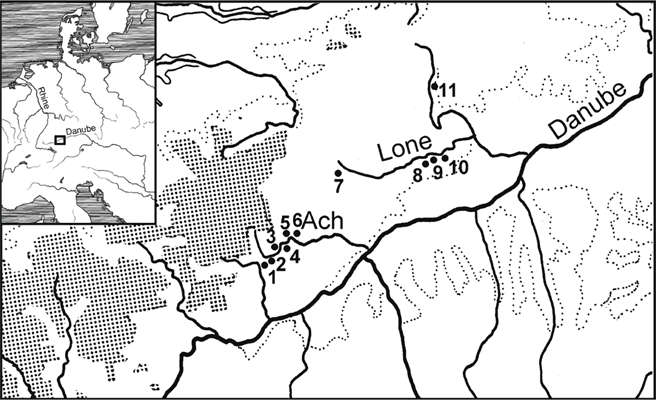
Map showing the major Middle Paleolithic and Aurignacian sites in the Swabian Jura.
1: Kogelstein;
2: Hohle Fels;
3: Sirgenstein;
4: Geißenklösterle;
5: Brillenhöhle;
6: Große Grotte;
7: Haldenstein;
8: Bockstein (Bockstein-Höhle, Bocksteinloch, Bocksteinschmiede, and
Bockstein-Törle);
9: Hohlenstein (Stadel and Bärenhöhle);
10: Vogelherd;
11: Heidenschmiede
(note that the Ach is mislabelled on this map, it is a tributary of the Blau, and should over most of its length shown here, especially as it approaches the Danube, be labelled as the Blau - Don )
Photo: Conard et al. 2011
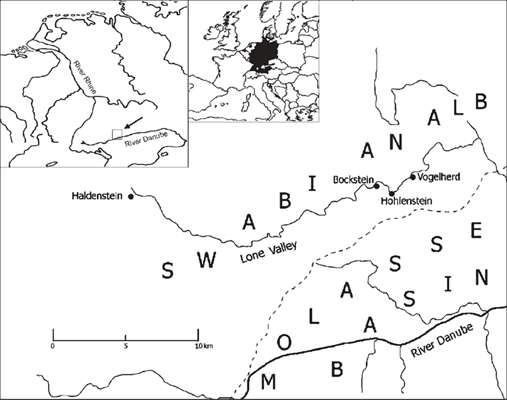
Map showing
• Haldenstein
• Bockstein (Bockstein-Höhle, Bocksteinloch, Bocksteinschmiede, and Bockstein-Törle)
• Hohlenstein (Stadel and Bärenhöhle)
• Vogelherd.
Photo: Krönneck et al. (2004)

Map showing
• Bockstein
• Hohlenstein
• Vogelherd.
It is 1.4 Km in a direct line from Bockstein to Hohlenstein, and 2 Km in a direct line from Hohlenstein to Vogelherd.
Photo: Google Earth
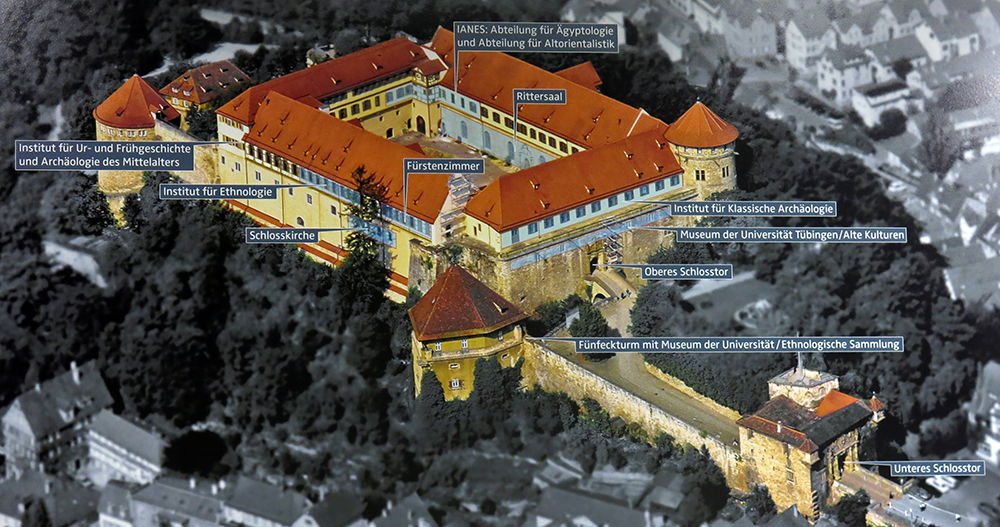
Those wishing to see the display of artefacts from Vogelherd should go to Hohentübingen Castle, not to one of the many other buildings used by the Universität Tübingen in the town of Tübingen.
Photo: Unknown, rephotographed by Don Hitchcock 2015
Source: Display, Museum der Universität Tübingen, Hohentübingen Castle

There is a magnificent view from the ramparts of the castle.
Photo: Don Hitchcock 2015
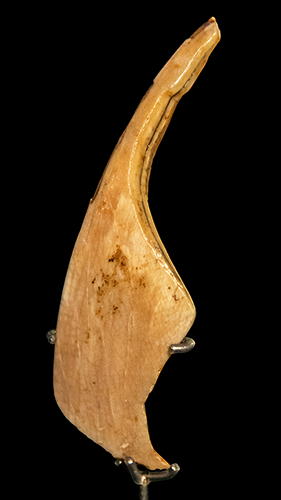
Vogelherd Venus - a venus sculpture from Vogelherdhöhle in the Lalinde/Gönnersdorf tradition.
The figurine is made from a boar tusk, found at the 2008 re-excavation of the materials from the Riek excavation of 1931 in front of the Vogelherdhöhle cave.
It is of Magdalenian age, about 13 000 BP.
Photo: Thilo Parg / Wikimedia Commons
Permission: CC BY-SA 3.0
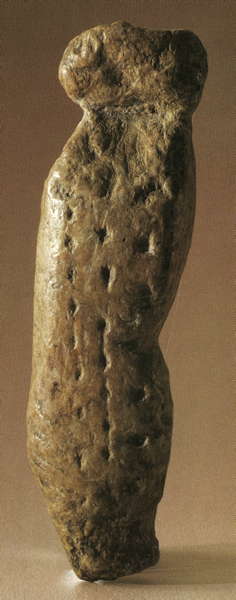
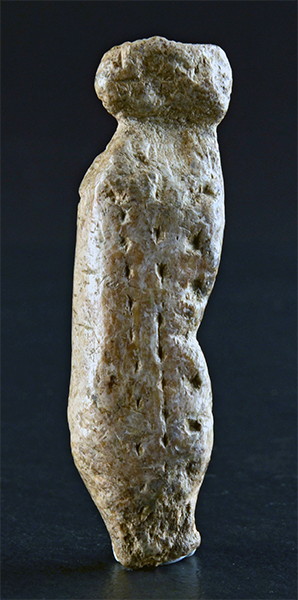
Vogelherd anthropomorphic statuette.
Length 69 mm, depth 10.5 mm, width 19 mm according to Müller-Beck et al. (1987).
However it was in this milieu that a number of quality works of art were collected, a large series of animal sculptures in ivory (mammoth, horse, bison, bears, reindeer, wolf, panther?), and in the upper layer 4, a human figure.
It has a height of 68 mm. It is ivory, carved in fact on one side only and is quite clumsily made, although the flattened head and trunk are relatively well treated, the back line, the camber of the small of the back and a draft gluteal projection are shown, the body has two rows of small cupules and a series of incisions whose meaning remains enigmatic.
A. Leroi-Gourhan class of animal figurines Vogelherd II in style, in principle, in the same period as that which marks, in France, the late-Aurignaco-Perigordian and Early Solutrean. Unfortunately we do not know the exact position of discovery of the statue in the stratigraphy of layer 4, that is to say in the most recent Aurignacian layer. It is not forbidden to think, under these conditions, it may have been associated with the Gravettian points, and it could be contemporaneous with female statuettes of the Western Upper Perigordian. The fact should be emphasised, however, that this model - which has some similarities with that of Trou-Magrite, Belgium - is not likely to be formally considered feminine. It is believed to date to 30 700 BP.
Photo (left): Müller-Beck et al. (1987)
Photo (right): Museopedia, Creative Commons Attribution-Share Alike 4.0 International license
Text: Delporte (1993)
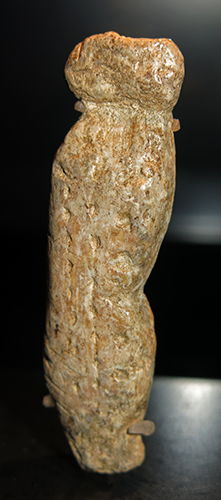

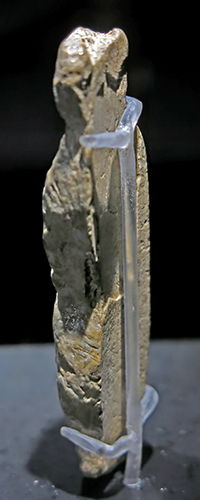

Vogelherd anthropomorphic statuette.
Photo: Don Hitchcock 2015
Source: Original, Museum der Universität Tübingen, Hohentübingen Castle
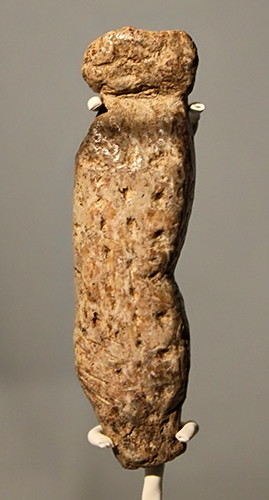
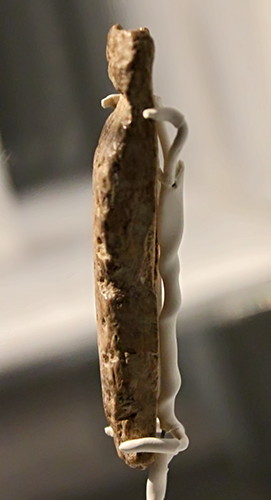
Vogelherd anthropomorphic statuette.
Photo: Ralph Frenken
Source and text: Original, exhibited at the Archeological Museum Hamburg (Ice Age - The Art of the Mammoth Hunters from 18 October 2016 to 14 May 2017)
On loan from the Museum der Universität Tübingen, Hohentübingen Castle
Text below from: http://www.ice-age-art.de/anfaenge_der_kunst/vogelherd.php
Vogelherd cave is located on the edge of the Lone valley, about 1 km northwest of Stetten and northeast of the Alb-Donau county (Alb-Donau-Kreis). Vogelherd cave is a very scenic place and well worth a visit, as indeed is all of the Lone valley. There is a place for open-air grilling directly above the cave. The cave is not visible from the road and one must first walk over a ridge to gain access to the three entrances on the edge of the Lone valley.
The cave covers an area of 170 square meters. This extremely important site, rich in finds, was first discovered when Stone Age artefacts turned up from a badger’s burrow. The actual size of it only became apparent after the excavations by Gustav Riek in the summer of 1931. The finds range from the Middle Palaeolithic to modern times. The world-renowned ivory carvings originate from the Middle Aurignacian period.
35 000-Year-Old Mammoth Sculpture Found in Germany
In southwestern Germany, an American archaeologist and his German colleagues have found the oldest mammoth-ivory carving known to modern science. And even at 35 000 years old, it's still intact.
Archaeologists at the University of Tübingen have recovered the first entirely intact woolly mammoth figurine from the Swabian Jura, a plateau in the state of Baden-Württemberg, thought to have been made by the first modern humans some 35 000 years ago. It is believed to be the oldest ivory carving ever found. "You can be sure," Tübingen archaeologist Nicholas J. Conard told SPIEGEL ONLINE, "that there has been art in Swabia for over 35 000 years."
In total, five mammoth-ivory figurines from the Ice Age were newly discovered at the site of the Vogelherd Cave in southwestern Germany, a site known to contain primitive artefacts since it was excavated in 1931 by the Tübingen archaeologist Gustav Reik. Over 7 000 sacks of sediment later, archaeologists were again invigorated by the discoveries.
Among the new finds are well-preserved remains of a lion figurine, fragments of a mammoth figurine and two as-yet-unidentified representations. These, the University of Tübingen Web site explains, "count among the oldest and most impressive examples of figurative artworks from the Ice Age."
Conard said that "the excitement and thrill were immense." He and his colleagues Michael Lingnau and Maria Malina in the Department of Early Prehistory and Quaternary Ecology reported their findings in the journal Archäologische Ausgrabungen in Baden-Württemberg.
The figure of the woolly mammoth is tiny, measuring just 3.7 cm long and weighing a mere 7.5 grams, and displays skilfully detailed carvings. It is unique in its slim form, pointed tail, powerful legs and dynamically arched trunk. It is decorated with six short incisions, and the soles of the pachyderm's feet show a crosshatch pattern. The miniature lion is 5.6 cm long, has a extended torso and outstretched neck. It is decorated with approximately 30 finely incised crosses on its spine.
The geological context of the discoveries and radiocarbon dating indicate that the figurines belong to the Aurignacian culture, which refers to an area of southern France and is associated with the arrival of the first modern humans in Europe. Multiple radiocarbon dates from sediment in the Vogelherd Cave yielded ages between 30 000 and 36 000 years ago, the University of Tübingen reports. Some methods give an even older date.
The preliminary results from the excavation will be presented in a special exhibit at the Museum of Prehistory in Blaubeuren from June 24, 2007 to January 13, 2008. In 2009, the figurines will be displayed in a major state exhibition in Stuttgart entitled "Cultures and Art of the Ice Age."
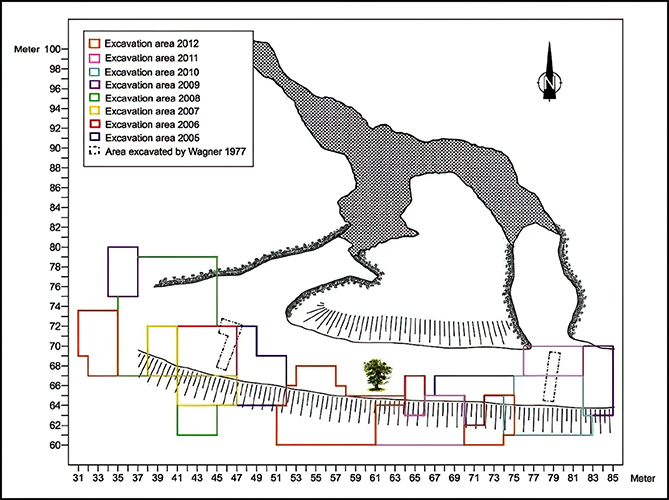
Vogelherd Cave. Areas of recent excavations in the backdirt of Riek’s 1931 fieldwork. Modified after Conard et al. 2013b.
Source: Boger et al. (2014)
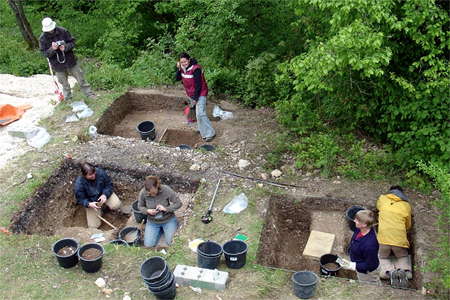
The figurines were found in 2007 in the spoil from the dig in 1931 by Riek, who completely dug out the site.
Modern practice is to take out a sample only, and leave much of the site for later investigators.
Photo: © Universität Tübingen
Source: http://www.spiegel.de/fotostrecke/fotostrecke-22586.html
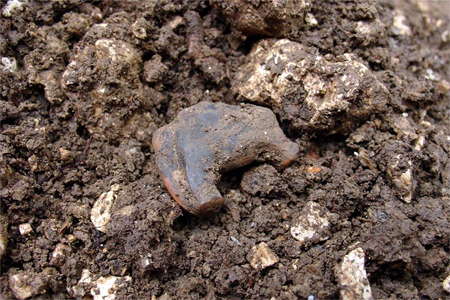
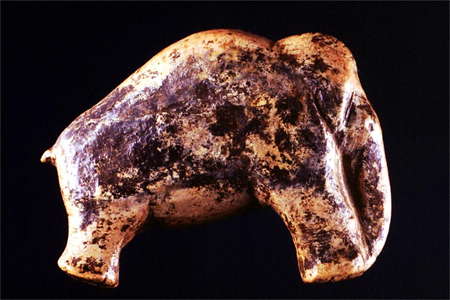
This 37mm long, 7.5 gram figurine, made from mammoth ivory, is some 35 000 years old. It is one of the oldest pieces of art ever found.
(left) as found at the site, (right) cleaned up for public display. On the right and left of the head are small incisions which represent the tusks.
Photo: © Universität Tübingen
Source and text: http://www.spiegel.de/fotostrecke/fotostrecke-22586.html
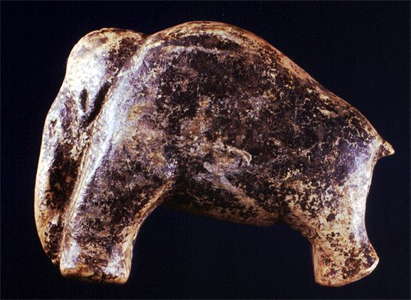
Another view of the mammoth.
The piece was found in 2007 in the spoil originally excavated from the Vogelherd Cave in 1931. A total of five figurines have been found there.
Small but clearly visible eyes and ears have been carved into the head.
Photo: http://www.facebook.com/media/set/?set=a.150023071682921.30804.149716745046887&type=1
Source: Probably © Universität Tübingen

Left, right, front, back, top and bottom views of the mammoth.
This mammoth is the first intact example found in the Vogelherd Cave. A number of other fragments have been dug up there.
Length 37 mm, weight 7.5 grams.
Photo: © Universität Tübingen
Source and text: http://www.spiegel.de/fotostrecke/fotostrecke-22586.html
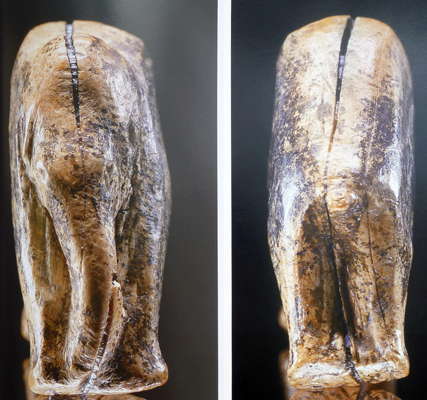
This image shows the front and rear views of the mammoth.
The figurine has split longitudinally at a zone of weakness in the mammoth ivory.
Six small incisions on the head are transverse to the longitudinal axis of the animal.
Photo: Rau et al. (2009)
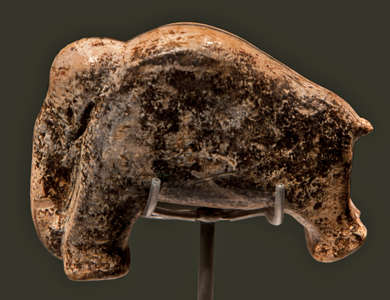
The mammoth was found in the overburden from the excavation by Gustav Rieks in 1931.
Aurignacian, length 37 mm, height 27 mm, depth 14 mm, weight 5.3 g
Photo: Silosarg
Permission: Creative Commons License Attribution-Noncommercial-Share Alike 3.0 Unported
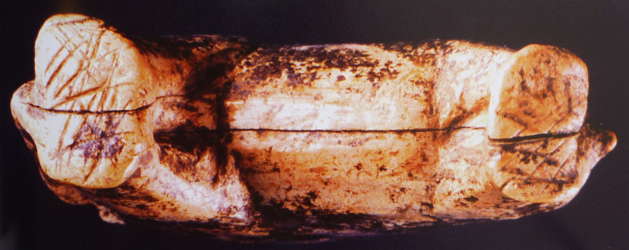
The underneath of the mammoth. Note the crosshatching on the soles of the feet.
Photo: Rau et al. (2009)

The mammoth is in very good condition, considering its age.
Photo: Rau et al. (2009)
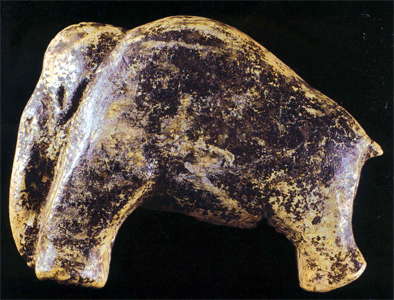
Another version of the mammoth sculpture.
Photo: Original, http://www.landschaftsmuseum.de/Seiten/Lexikon/Kunst_Pal-2.htm
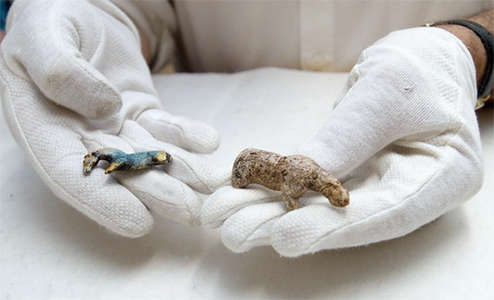
This photograph shows the small size of the famous Vogelherd horse and the newly completed lion/bear from Vogelherd.
The horse has the dimensions 48 mm wide, 25 mm high, 7 mm thick.
Photo: Gerlinde Trinkhausstraße
Source: http://www.gea.de/bilder/bildergalerien/40000+jahre+alte+figur+komplettiert.3269182.htm
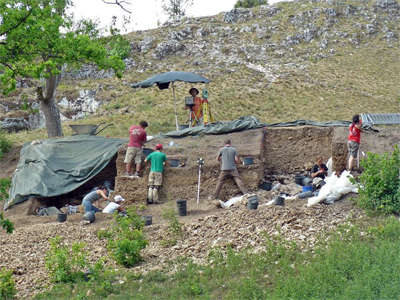
Re-excavation of the sediments from Vogelherd Cave.
Photo: Mohsen Zeidi. © University of Tübingen
Source: http://earth-chronicles.ru/news/2013-07-19-47253

Bovid from Vogelherd.
Photo: Rau et al. (2009)
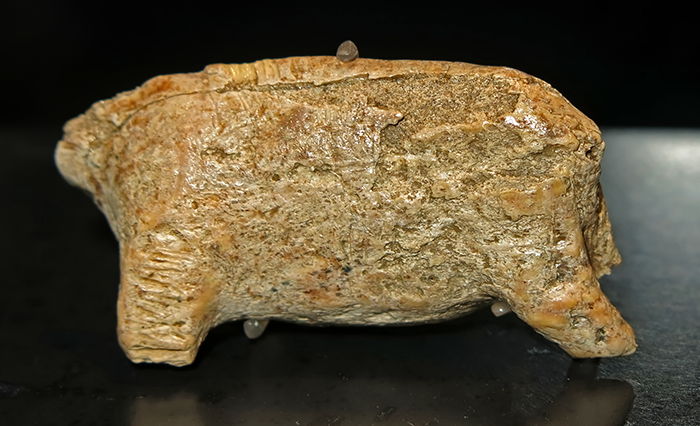

Bovid, mammoth ivory, circa 35 000 years old.
Photo: Don Hitchcock 2015
Source: Original, Museum der Universität Tübingen, Hohentübingen Castle
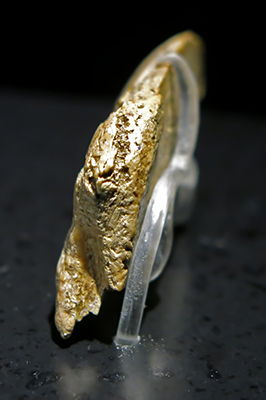
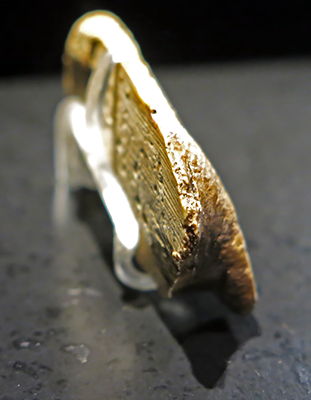
Bovid, circa 35 000 years old.
The striations of the cleavage plane may be a natural feature of ivory.
Photo: Don Hitchcock 2015
Source: Original, Museum der Universität Tübingen, Hohentübingen Castle
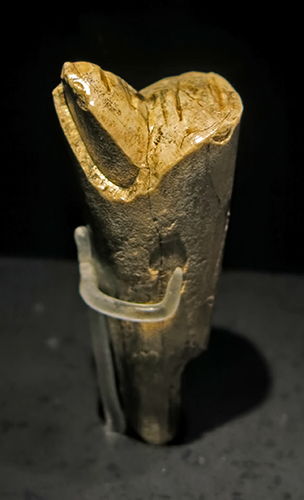
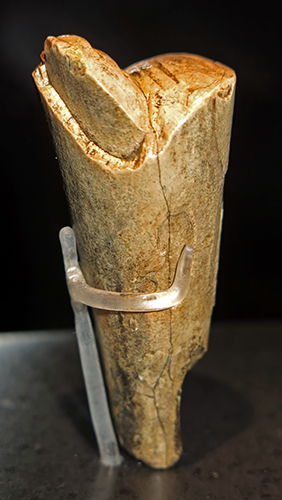
Mammoth legs in mammoth ivory, circa 35 000 years old.
Photo: Don Hitchcock 2015
Source: Original, Museum der Universität Tübingen, Hohentübingen Castle
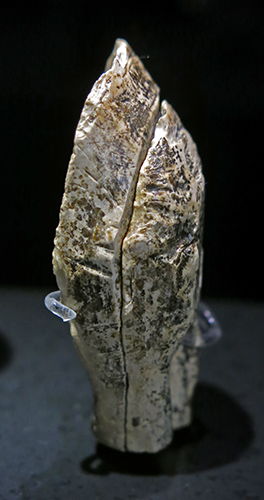
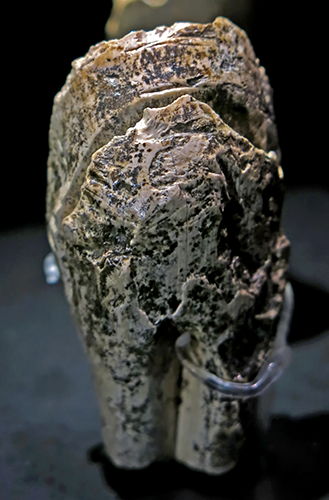

Mammoth rump in mammoth ivory, circa 35 000 years old.
Photo: Don Hitchcock 2015
Source: Original, Museum der Universität Tübingen, Hohentübingen Castle
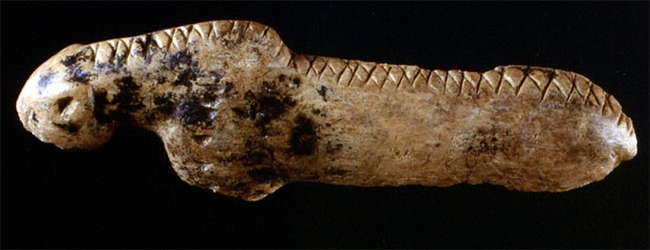
This miniature lion is 56 mm long, has an extended torso and an outstretched neck. It is decorated with approximately 30 finely incised crosses on its spine.
A number of other figurines have likewise been found at the site, says University of Tübingen archaeologist Nicholas J. Conard. They are, says the university Web site, 'among the oldest and most impressive examples of figurative artworks from the Ice Age.'
Photo: © Universität Tübingen
Source and text: http://www.spiegel.de/fotostrecke/fotostrecke-22586.html
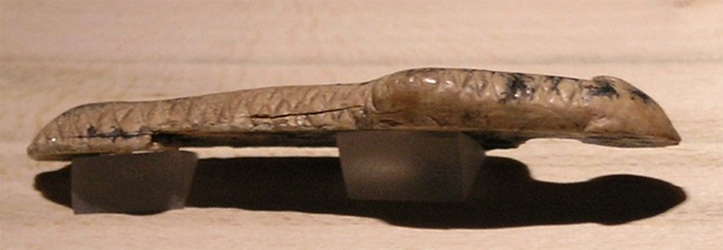
View of the lion from above.
Photo: http://www.epochtimes.de/gallery/2007/11/12/195374-2.html
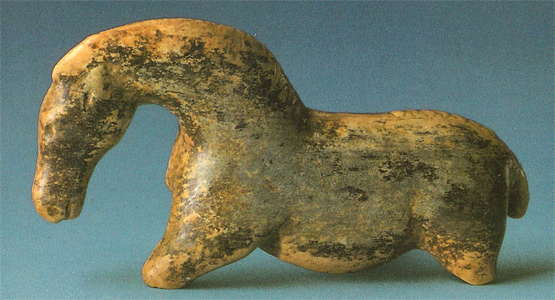
The mammoth ivory horse from Vogelherd. It has been superbly finished, with loving care given to the polishing of the sculpture by a master artist.
Photo: Müller-Beck et al. (1987)
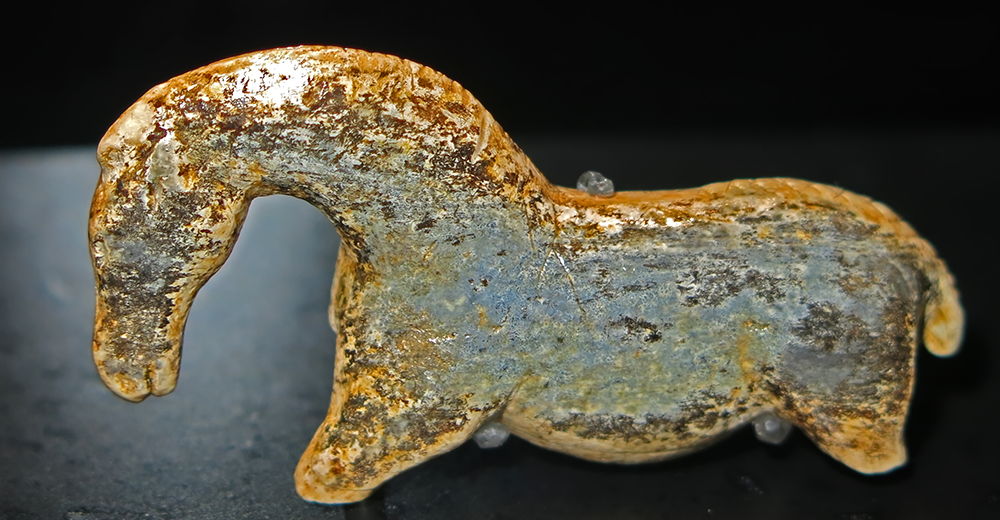
Horse sculpture.
Photo: Don Hitchcock 2015
Source: Original, Museum der Universität Tübingen, Hohentübingen Castle

Vogelherd horse sculpture.
Photo: Don Hitchcock 2015
Source: Original, Museum der Universität Tübingen, Hohentübingen Castle
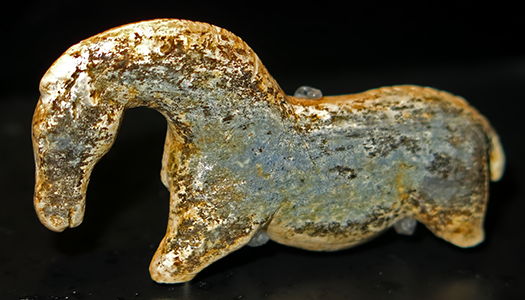
Vogelherd horse sculpture, showing marks of tooling on the neck.
Photo: Don Hitchcock 2015
Source: Original, Museum der Universität Tübingen, Hohentübingen Castle
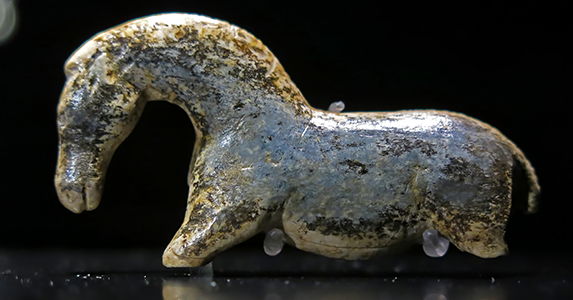
Vogelherd horse sculpture, showing clearly the abdomen and front foot.
Photo: Don Hitchcock 2015
Source: Original, Museum der Universität Tübingen, Hohentübingen Castle
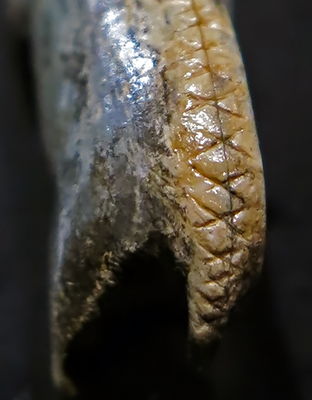
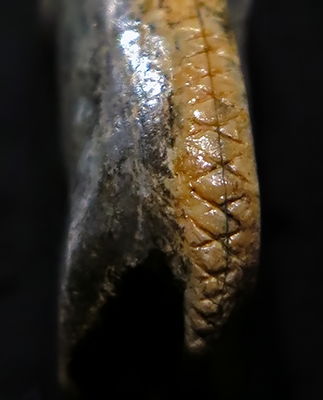
Vogelherd horse sculpture, showing the crosses extending from the back of the horse down the tail.
Photo: Don Hitchcock 2015
Source: Original, Museum der Universität Tübingen, Hohentübingen Castle
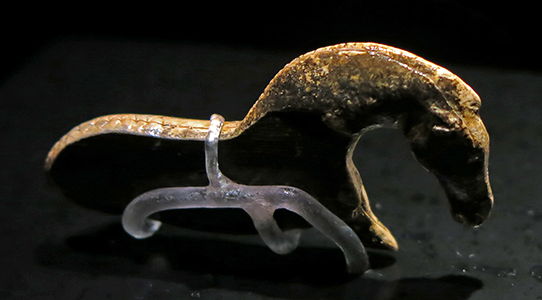
Vogelherd horse sculpture.
This shows the back of the horse. The head and neck is still in three dimensions, but the rest of the horse sculpture has been split off by a fault in the ivory.
Photo: Don Hitchcock 2015
Source: Original, Museum der Universität Tübingen, Hohentübingen Castle
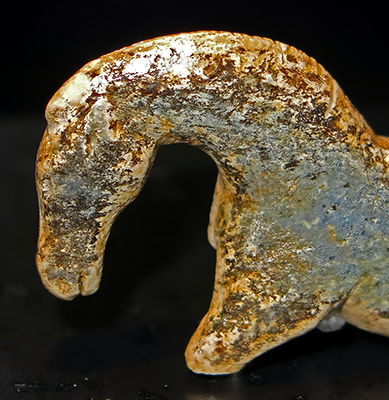
Close up of the horse head and shoulders.
Photo: Don Hitchcock 2015
Source: Original, Museum der Universität Tübingen, Hohentübingen Castle
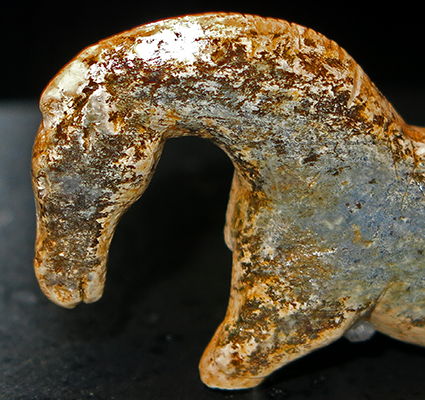
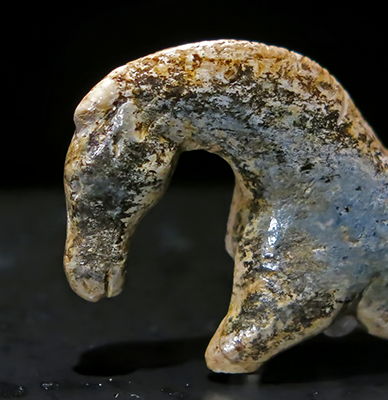
Close up of the horse head and shoulders.
Photo: Don Hitchcock 2015
Source: Original, Museum der Universität Tübingen, Hohentübingen Castle
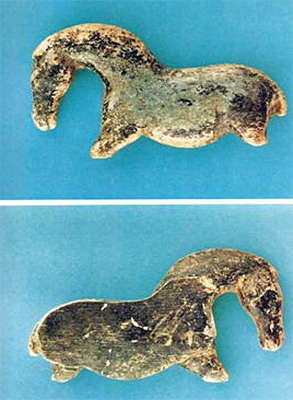
Another view of the flat side of the horse.
Photo: Adam et al. (1980)
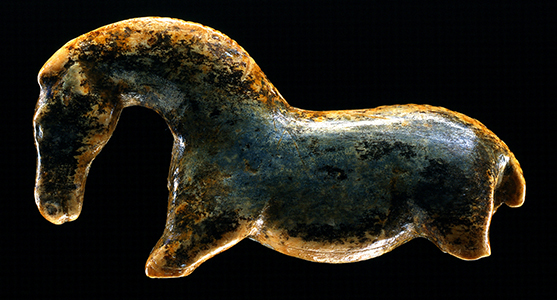
A very good image of the horse
Photo: https://www.unimuseum.uni-tuebingen.de/en/collections/collection-of-the-older-prehistory.html
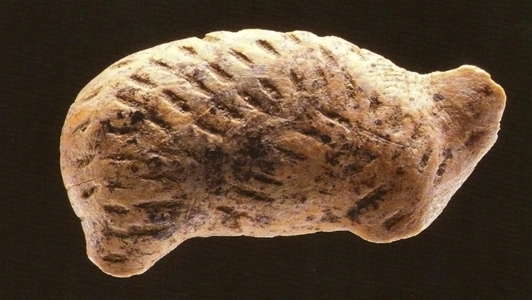
Animal, Vogelherd.
Photo: Rau et al. (2009)
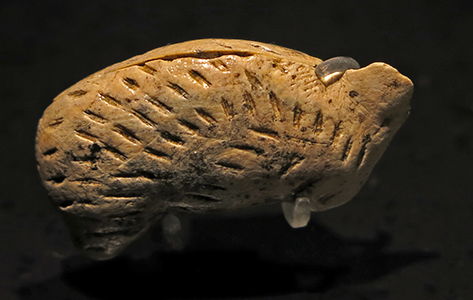
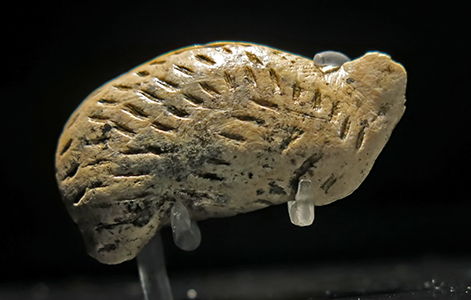
Animal, circa 35 000 years old.
Photo: Don Hitchcock 2015
Source: Original, Museum der Universität Tübingen, Hohentübingen Castle
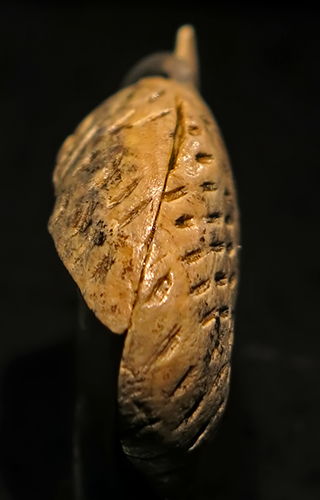
Animal, as above, circa 35 000 years old.
Seen from above. Many of the Vogelherd figurines are split along the central axis.
Photo: Don Hitchcock 2015
Source: Original, Museum der Universität Tübingen, Hohentübingen Castle
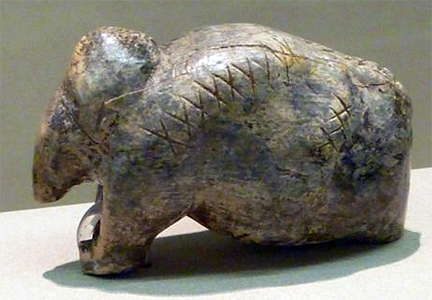
Mammoth sculpture
Photo: Ralph Frenken
Source: Original, Museum der Universität Tübingen
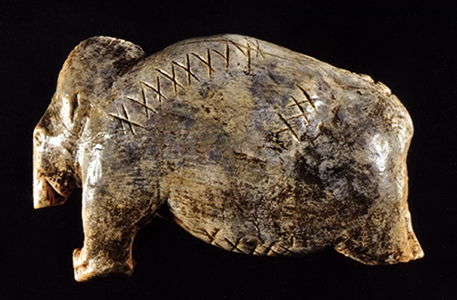
Mammoth sculpture
Photo: Cook (2013)
Source: Original, Museum der Universität Tübingen

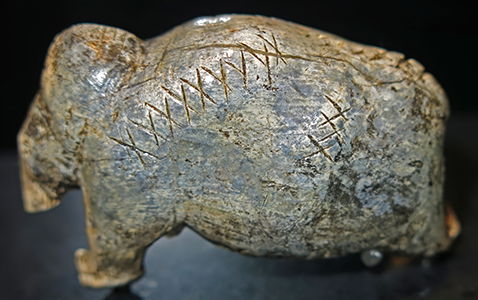
The sculpture is in fairly good condition, with little damage or missing sections.
Photo: Don Hitchcock 2015
Source: Original, Museum der Universität Tübingen, Hohentübingen Castle
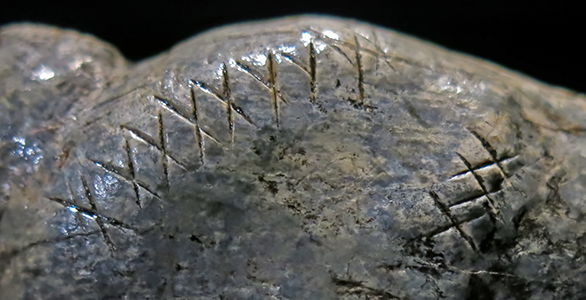
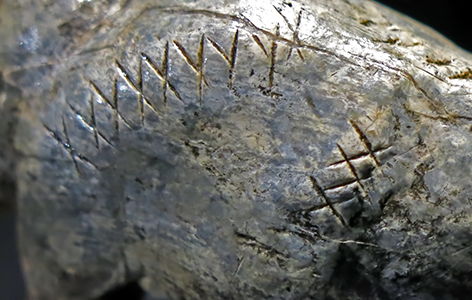
The recurring theme of crosses on the sculpture seems to indicate that the marks have significant meaning. Crosses have been carved into the shoulders, loins, abdomen, the back of the head, and above the tail on the croup.
Photo: Don Hitchcock 2015
Source: Original, Museum der Universität Tübingen, Hohentübingen Castle

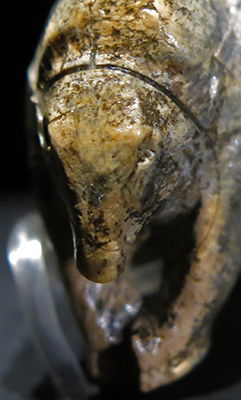
No attempt seems to have been made to indicate tusks, yet the massive and powerful proportions of the body would indicate that the mammoth had reached maturity.
Photo: Don Hitchcock 2015
Source: Original, Museum der Universität Tübingen, Hohentübingen Castle
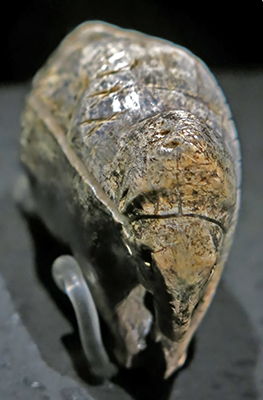
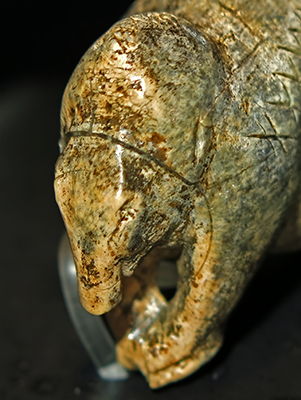
The positioning of the front feet means that the sculpture could have been easily used as a pendant. It is only 5 cm long, so this is an entirely feasible use for the sculpture.
Photo: Don Hitchcock 2015
Source: Original, Museum der Universität Tübingen, Hohentübingen Castle
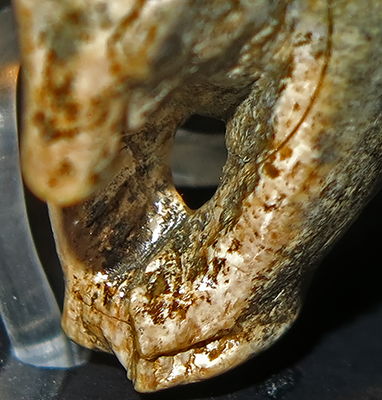
This closeup allows us to see clearly the hole suitable for attaching the figurine as a pendant by passing a cord through the gap in the front legs.
Photo: Don Hitchcock 2015
Source: Original, Museum der Universität Tübingen, Hohentübingen Castle
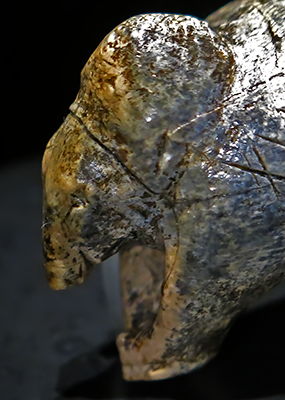
This closeup shows the modelling of the face of the mammoth to advantage. Again, there is no indication of tusks.
Photo: Don Hitchcock 2015
Source: Original, Museum der Universität Tübingen, Hohentübingen Castle
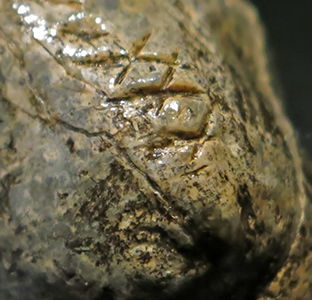
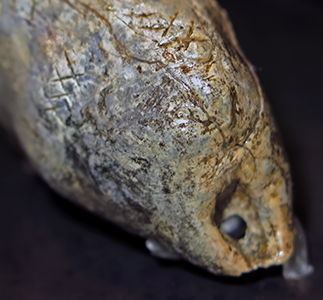
There is a further hole for suspending the sculpture at the rear of the figurine.
Photo: Don Hitchcock 2015
Source: Original, Museum der Universität Tübingen, Hohentübingen Castle
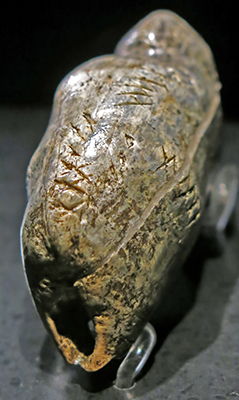
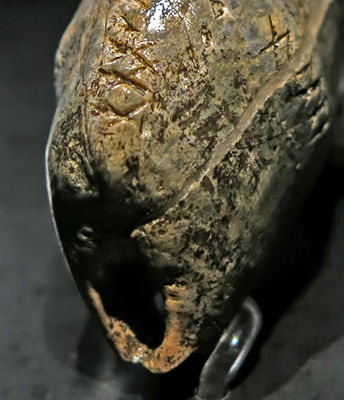
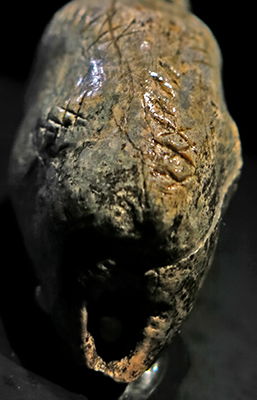
The line of the spine at the croup, the rear of the animal, has also been decorated with crosses.
Photo: Don Hitchcock 2015
Source: Original, Museum der Universität Tübingen, Hohentübingen Castle
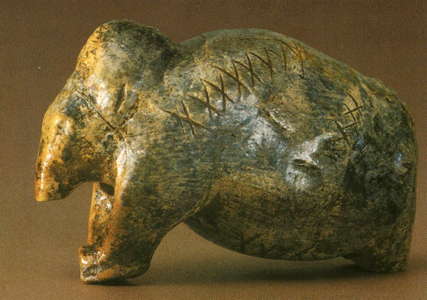
Mammoth sculpture, as above.
Length 50 mm, height 31 mm, breadth 22 mm.
Photo: Müller-Beck et al. (1987)
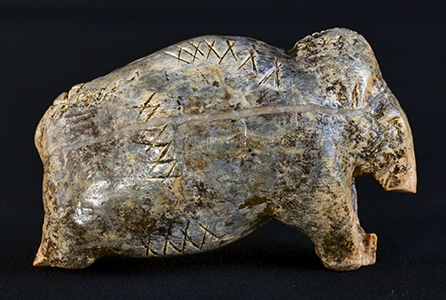
A recent high definition image of the mammoth.
Source: Boger et al. (2014)

Cave Lion sculpture. Note the missing section at the rear of the animal.
Length 68 mm, height 24 mm, breadth 14.5 mm.
Photo: Müller-Beck et al. (1987)
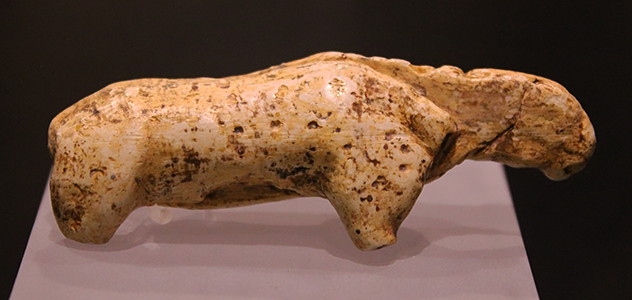
Cave lion.
This is an important photo, because it shows the rarely seen other side of the sculpture.
Photo: Ralph Frenken
Source: exhibited at the Archeological Museum Hamburg (Ice Age - The Art of the Mammoth Hunters from 18 October 2016 to 14 May 2017)
On loan from the Museum der Universität Tübingen.
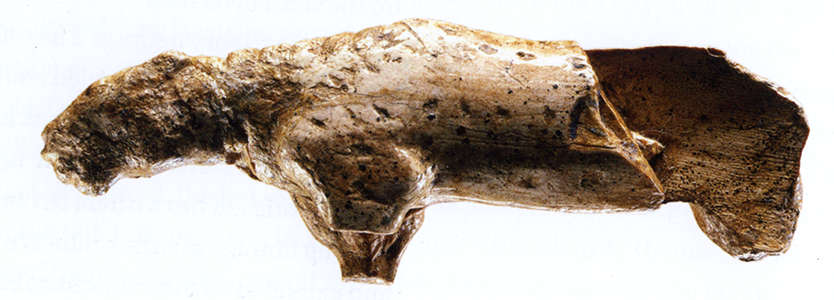
Cave Lion sculpture, as above.
Photo: Cook (2013)

Cave Lion sculpture.
Photo: Don Hitchcock 2015
Source: Original, Museum der Universität Tübingen, Hohentübingen Castle
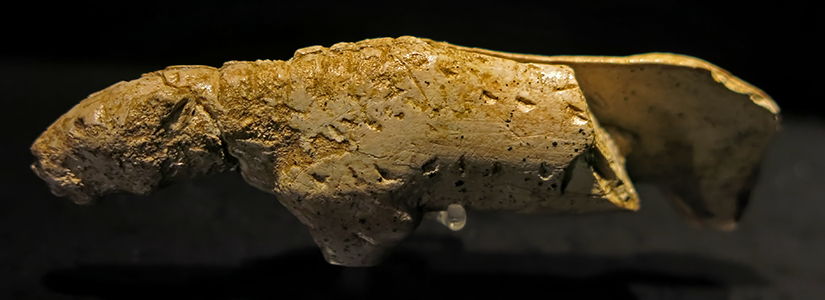
Parts of the surface have eroded away, and the rear left section has split off, but the sculpture remains a powerful piece of art.
Photo: Don Hitchcock 2015
Source: Original, Museum der Universität Tübingen, Hohentübingen Castle
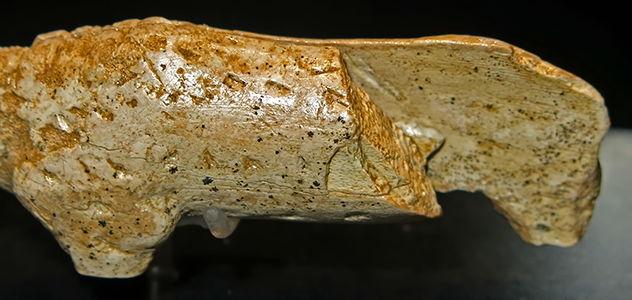
Longitudinal striations appear on the cleaved surface when the ivory splits, as shown at the rear of the figure, running from front to back of the figure.
In addition, there are cleavage patterns at right angles to these, as can be seen here.
Photo: Don Hitchcock 2015
Source: Original, Museum der Universität Tübingen, Hohentübingen Castle
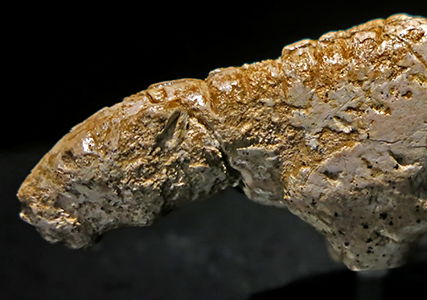

The nape of the neck is curiously done, with projections separated by carved grooves.
Photo: Don Hitchcock 2015
Source: Original, Museum der Universität Tübingen, Hohentübingen Castle
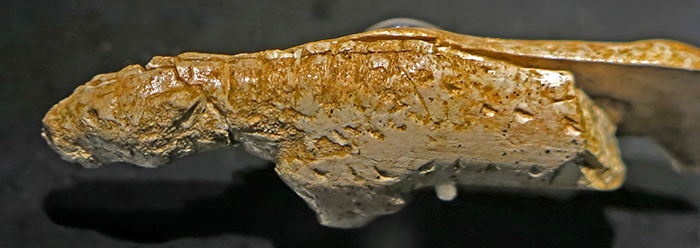
The mammoth ivory has at least two cleavage planes evident.
Photo: Don Hitchcock 2015
Source: Original, Museum der Universität Tübingen, Hohentübingen Castle
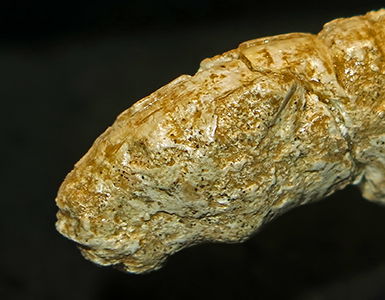

Much of the fine detail of the head has been lost, but the general proportions indicate the artistry involved.
Photo: Don Hitchcock 2015
Source: Original, Museum der Universität Tübingen, Hohentübingen Castle
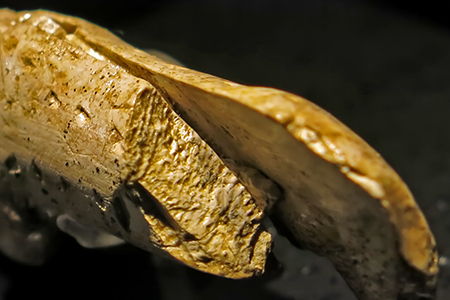
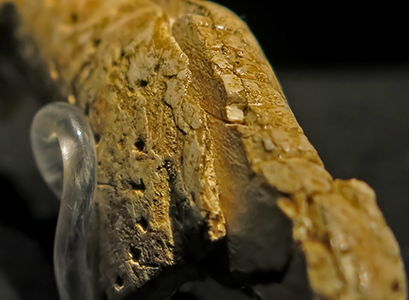
Detail of the split section of the artwork.
Photo: Don Hitchcock 2015
Source: Original, Museum der Universität Tübingen, Hohentübingen Castle
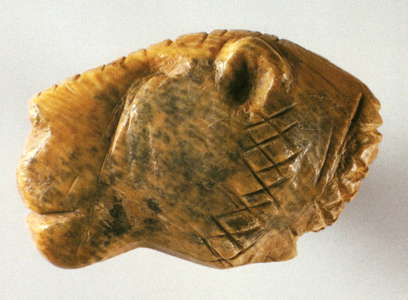
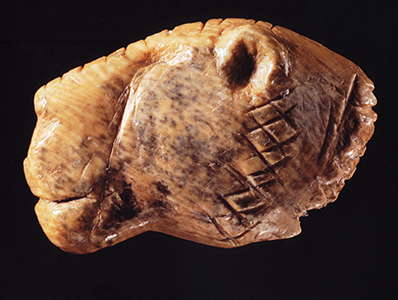
Cave Lion head, superbly detailed. It would be very interesting to determine the significance of the crosses carved into many of the animal figurines from Vogelherd.
Length 25 mm, height 18 mm, breadth 6 mm. It is part of a formerly complete statuette.
Photo (left): Müller-Beck et al. (1987)
Photo (right): Cook (2013)
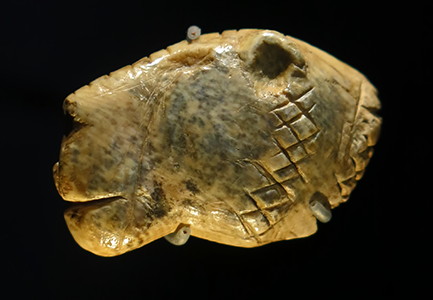
The King of Animals - strength and aggression, power and superiority characterise the lion. The head, carved from ivory, is only preserved on one side. Once it was part of a larger figure. The glacial sites of the Vogelherdhöhle harboured the most diverse and numerous artefacts of the earliest art of mankind.
Mammoth ivory, Vogelherdhöhle, Stetten ob Lontal, Niederstotzingen, Kreis Heidenheim.
Aurignacian, circa 40 000 - 35 000 BP
Photo: Don Hitchcock 2015
Source and text: Landesmuseum Württemberg, Stuttgart
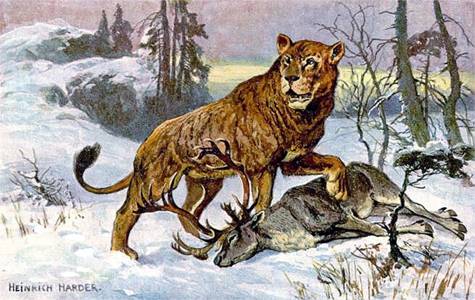
Cave Lion by Heinrich Harder
Photo: Heinrich Harder, Public Domain
The Cave Lion was about 10% bigger than the African lion. The cave lion is known from Paleolithic cave paintings, ivory carvings, and clay figurines. These representations indicate that cave lions had rounded, protruding ears, tufted tails, possibly faint tiger-like stripes, and that at least some had a "ruff" or primitive mane around their neck, indicating males.
The cave lion received its common name because large quantities of its remains are found in caves, but it is doubtful whether they lived in them. They probably preferred conifer forests and grasslands, where medium-sized to large herbivores occurred. Fossil footprints of lions, which were found together with those of reindeer, demonstrate that lions once occurred even in subpolar climates. The presence of fully articulated adult cave lion skeletons, deep in cave bear dens, indicates that lions may have occasionally entered dens to prey on hibernating cave bears, with some dying in the attempt.
These active carnivores probably preyed upon the large herbivorous animals of their time, including horses, deer, reindeer, bison and even injured old or young mammoths. Some paintings of them in caves show several hunting together, which suggests the hunting strategy of contemporary lionesses.
Its extinction may have been related to the Quaternary extinction event, which wiped out most of the megafauna prey in those regions. Cave paintings and remains found in the refuse piles of ancient camp sites indicate that they were hunted by early humans, which also may have contributed to their demise.
Text above adapted from Wikipedia
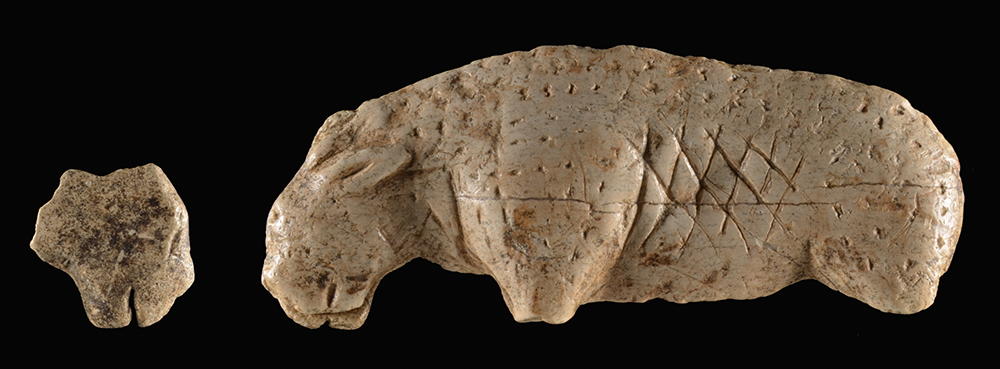
Cave Lion
The fragment on the left makes up half the head of the animal figure on the right, showing that the 'lion' was fully three-dimensional, and not a relief as long thought.
Photo Credit: Hilde Jensen, Universität Tübingen
Source: http://phys.org/news/2014-07-fragment-ice-age-ivory-lion.html#nRlv
Archaeologists from the University of Tübingen have found an ancient fragment of ivory belonging to a 40,000 year old animal figurine. Both pieces were found in the Vogelherd Cave in southwestern Germany, which has yielded a number of remarkable works of art dating to the Ice Age. The mammoth ivory figurine depicting a lion was discovered during excavations in 1931. The new fragment makes up one side of the figurine's head, and the sculpture may be viewed at the Tübingen University Museum from 30 July 2014.
'The figurine depicts a lion' says Professor Nicholas Conard of Tübingen University's Institute of Prehistory and Medieval Archaeology, and the Senckenberg Center for Human Evolution and Palaeoenvironment Tübingen. 'It is one of the most famous Ice Age works of art, and until now, we thought it was a relief, unique among these finds dating to the dawn of figurative art. The reconstructed figurine clearly is a three dimensional sculpture.'
The new fragment was discovered when today's archaeologists revisited the work of their predecessors from the 1930s. 'We have been carrying out renewed excavations and analysis at Vogelherd Cave for nearly ten years' says Conard. 'The site has yielded a wealth of objects that illuminate the development of early symbolic artefacts dating to the period when modern humans arrived in Europe and displaced the indigenous Neanderthals.' He points out that the Vogelherd Cave has provided evidence of the world's earliest art and music and is a key element in the push to make the caves of the Swabian Jura a UNESCO World Heritage site.
Vogelherd is one of four caves in the region where the world's earliest figurines have been found, dating back to 40 000 years ago. Several dozen figurines and fragments of figurines have been found in the Vogelherd alone, and researchers are piecing together thousands of mammoth ivory fragments.
Text above: http://phys.org/news/2014-07-fragment-ice-age-ivory-lion.html#nRlv
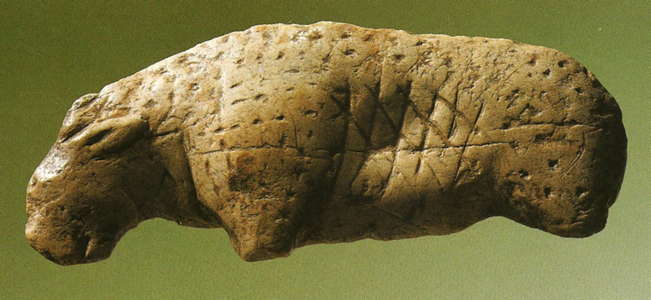
Cave lion.
Photo: Müller-Beck et al. (1987)
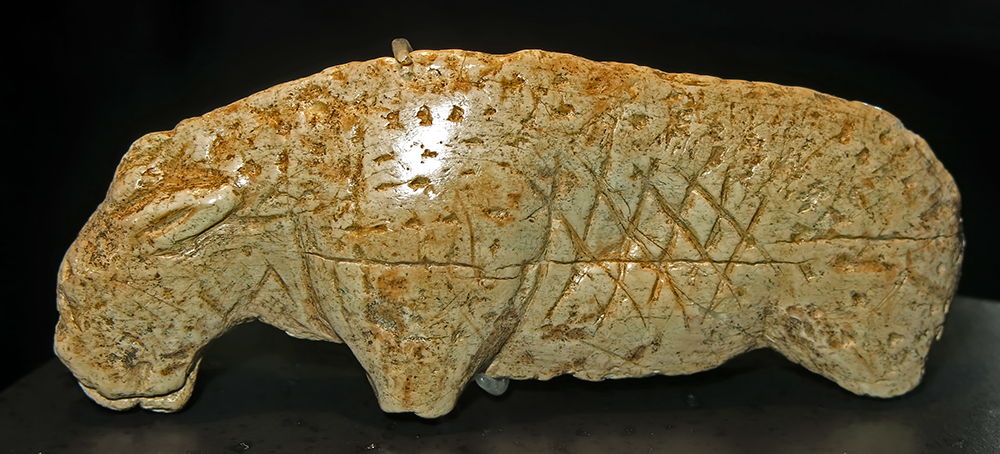
Photo: Don Hitchcock 2015
Source: Original, Museum der Universität Tübingen, Hohentübingen Castle
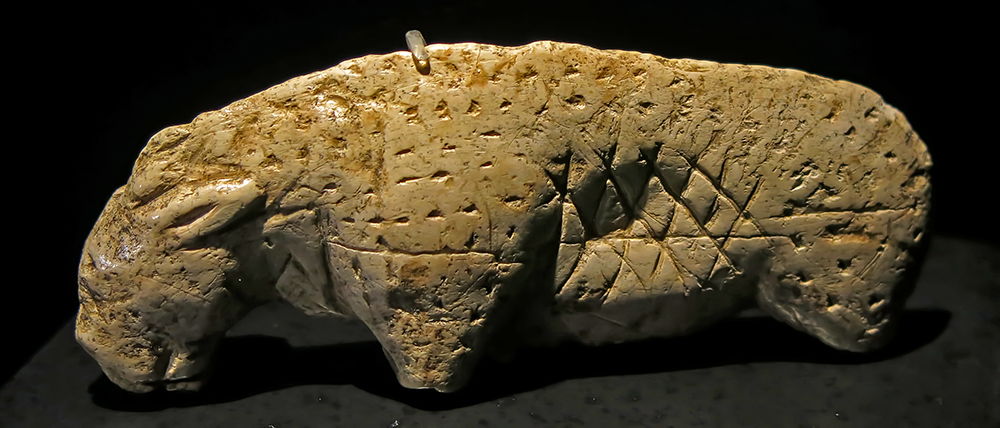
This photograph shows the sculptural quality of the piece, with, curiously, the section behind the left shoulder significantly indented compared with the rest of the torso.
Length 88 mm, height 34 mm, breadth 11 mm.
Photo: Don Hitchcock 2015
Source: Original, Museum der Universität Tübingen, Hohentübingen Castle
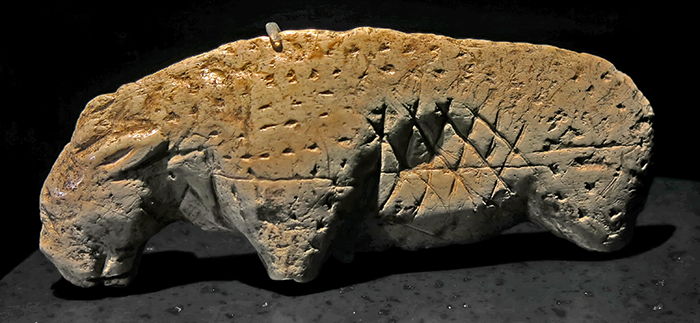
The piece has been marked with indentations showing, presumably, the coat of the animal, as well as a decorative pattern of criss - crossing lines, a variation on the more normal individual crosses placed often in a line on pieces from this site.
Photo: Don Hitchcock 2015
Source: Original, Museum der Universität Tübingen, Hohentübingen Castle
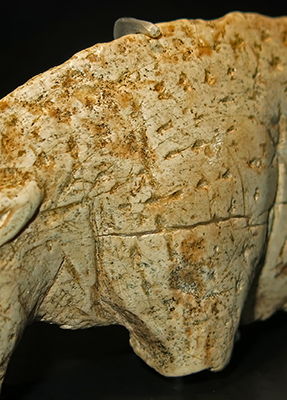

The power of the shoulder of the animal has been shown extremely well, despite the fact that the whole sculpture is very thin, with most of the other side missing.
Photo: Don Hitchcock 2015
Source: Original, Museum der Universität Tübingen, Hohentübingen Castle
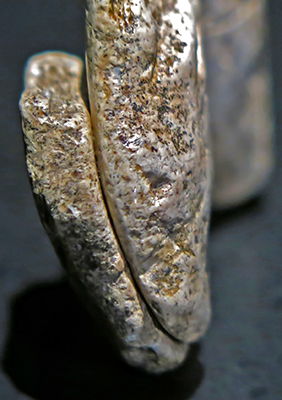
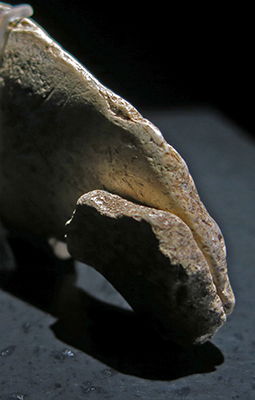
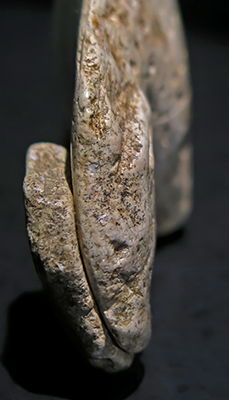
Until the second piece of the head was found, it was assumed that the sculpture was a bas relief, but this discovery shows that it was once carved in three dimensions.
Photo: Don Hitchcock 2015
Source: Original, Museum der Universität Tübingen, Hohentübingen Castle
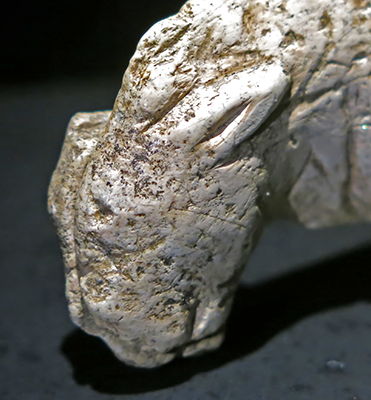
The head has been shown extremely well, and there has been little deterioration of the details.
Photo: Don Hitchcock 2015
Source: Original, Museum der Universität Tübingen, Hohentübingen Castle
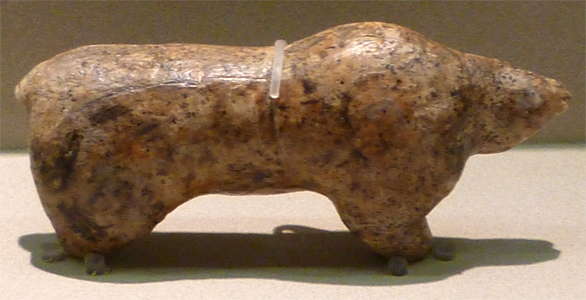
Sculpture originally thought to be a bear, now identified as a cave lion.
Photo: Ralph Frenken
Source: Original, Museum der Universität Tübingen

Sculpture, as above.
Müller-Beck et al. (1987) say that it has been identified as a lion, bear, or rhinoceros.
Length 58 mm, height 24 mm, breadth 14 mm.
Note that the head of this animal has now been discovered and reunited with the body, allowing its identification as a cave lion, see the complete sculpture in the photos below.
Photo: Müller-Beck et al. (1987)
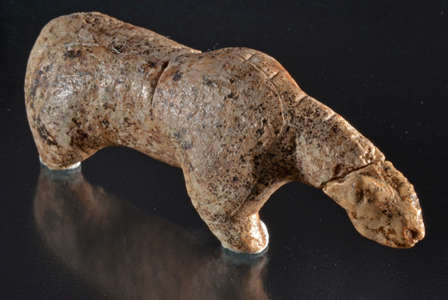
A Cave Lion figurine carved from mammoth ivory, now with refitted head. Found at Vogelherd Cave in southwestern Germany. Approx. 40 000 years old.
Researchers from the University of Tübingen have successfully reattached the newly discovered head of a prehistoric mammoth ivory figurine discovered in 1931.
The head was found during renewed excavations at Vogelherd Cave, site of the original dig in 1931. The recent excavations, between 2005 and 2012, have yielded a number of important finds.
The discovery of this ivory head helps to complete a figurine which now can be recognised as a lion – and demonstrates that it is possible to reassemble often fragmentary figurines from the earlier excavation. The new discovery is presented in the 2013 edition of the journal Archäologische Ausgrabungen in Baden-Württemberg.
Photo: H. Jensen. © University of Tübingen
Source: http://idw-online.de/pages/de/image?id=209130&size=screen
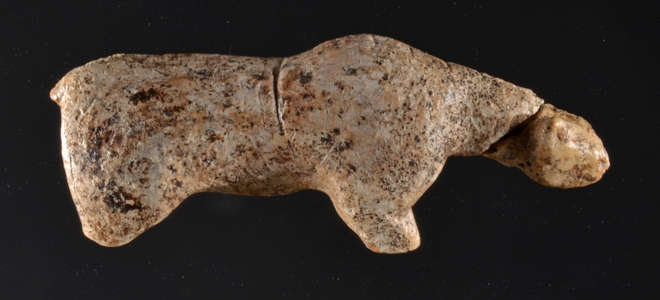
Vogelherd Cave is located in the Lone Valley (Lonetal) of southwestern Germany and is by far the richest of the four caves in the region that have produced examples of the earliest figurative art, dating as far back as 40 000 years ago. Overall, Vogelherd Cave has yielded more than two dozen figurines and fragments of figurines.
Photo: H. Jensen. © University of Tübingen
Source: http://idw-online.de/pages/de/image?id=209131&size=screen
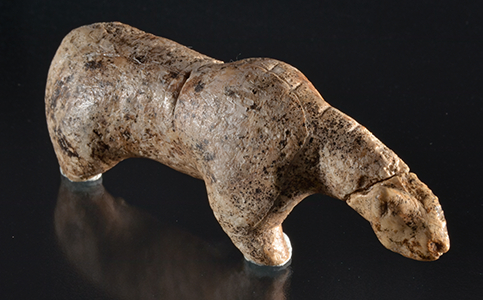
Another version of this important object.
Photo: Museopedia
Permission: Creative Commons Attribution-Share Alike 4.0 International license

While the work of fitting together thousands of small fragments of mammoth ivory from Vogelherd is just beginning, the remarkable cave lion figurine, now with its head, forms an important part of the display of the earliest art at the Museum of the University of Tübingen (MUT) in Hohentübingen Castle.
Professor Nicholas Conard and his excavation assistant Mohsen Zeidi today presented the new discovery and discussed its scientific importance, after which the find rejoined the permanent exhibit at MUT.
Photo: Gerlinde Trinkhausstraße
Source: http://www.gea.de/region+reutlingen/tuebingen/archaeologen+komplettieren+40000+jahre+alte+figur.3269157.htm
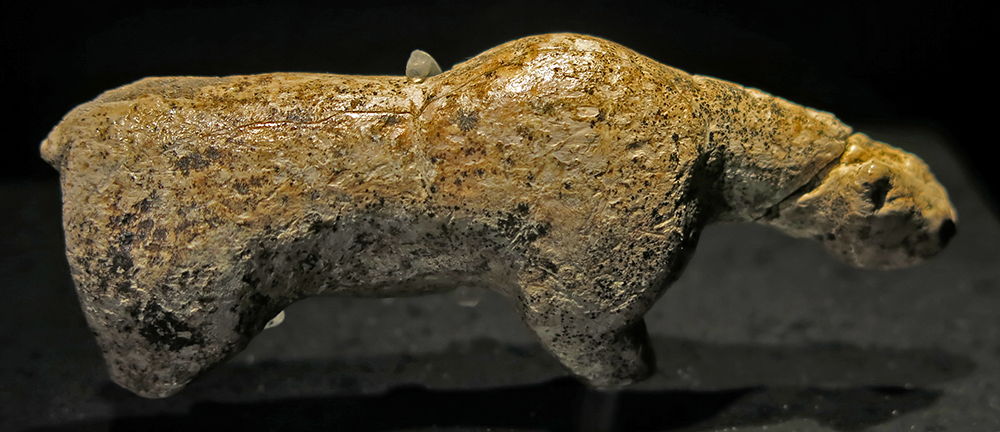
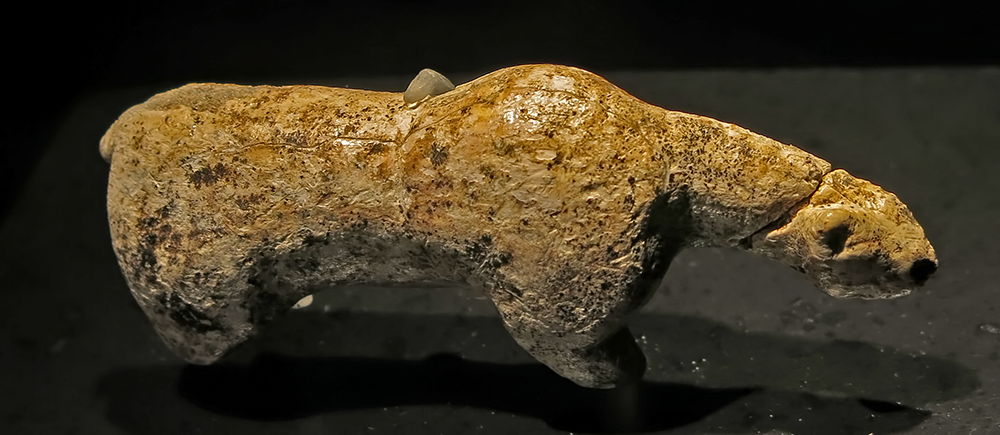


Cave Lion, circa 35 000 years old.
Photo: Don Hitchcock 2015
Source: Original, Museum der Universität Tübingen, Hohentübingen Castle
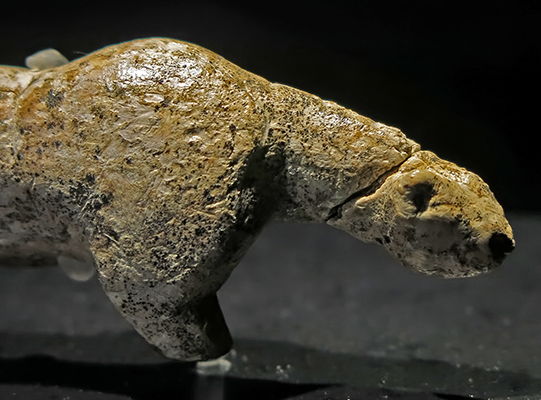

The head, neck, and shoulders show an animal at the peak of its powers, a formidable adversary.
Photo: Don Hitchcock 2015
Source: Original, Museum der Universität Tübingen, Hohentübingen Castle
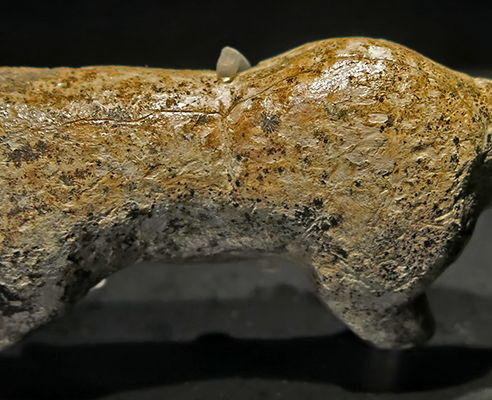
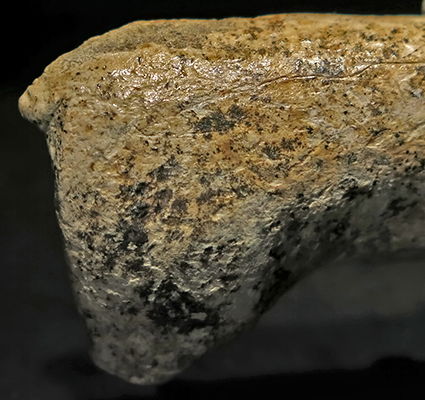
The body and hindquarters also show a highly muscular animal, one which could easily bring down bison or aurochs, or even a smaller mammoth.
Photo: Don Hitchcock 2015
Source: Original, Museum der Universität Tübingen, Hohentübingen Castle
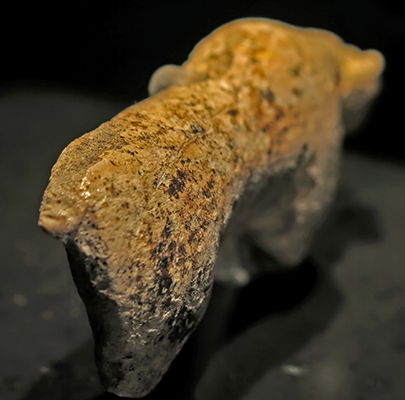

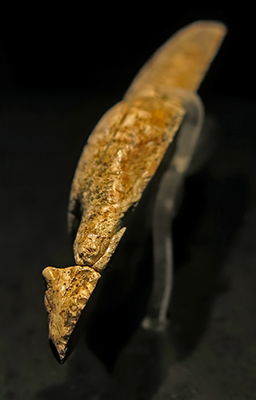
As with many of the figurines from this group, only one half has so far been discovered in the spoil from the original excavations.
The search continues.
Photo: Don Hitchcock 2015
Source: Original, Museum der Universität Tübingen, Hohentübingen Castle

Animal sculpture.
Length 63.5 mm, height 24.5 mm, breadth 17 mm.
The head may have been purposefully removed.
Photo: Cook (2013)
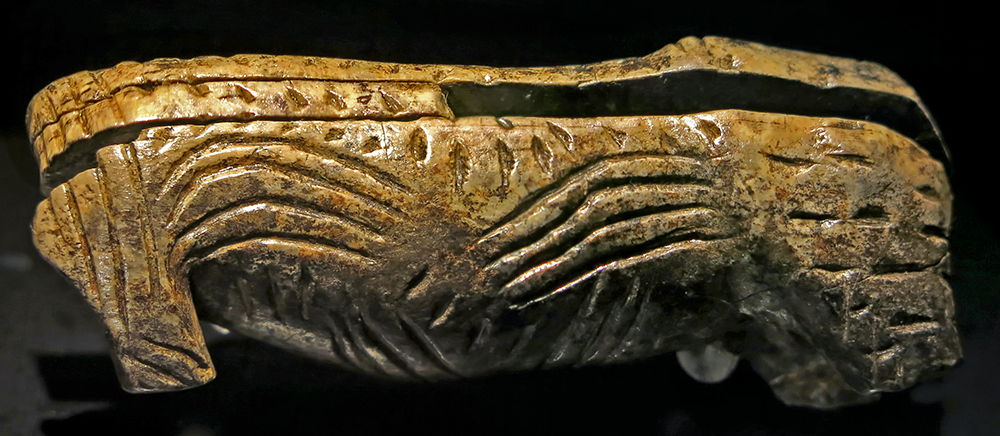
Abstract, deep engravings on the animal.
Photo: Don Hitchcock 2015
Source: Original, Museum der Universität Tübingen, Hohentübingen Castle
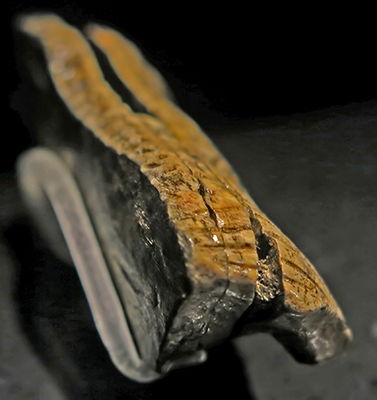
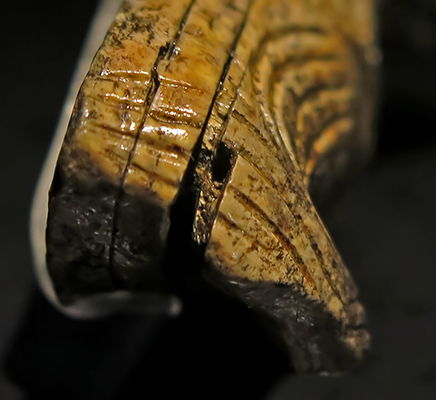
The front of the animal.
Photo: Don Hitchcock 2015
Source: Original, Museum der Universität Tübingen, Hohentübingen Castle
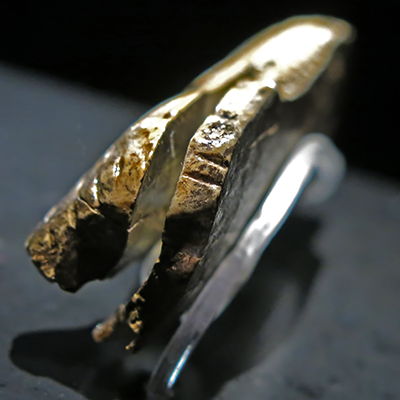
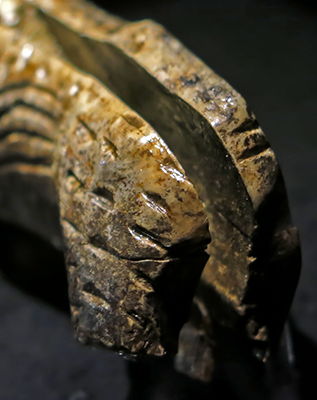
The rear of the animal.
Photo: Don Hitchcock 2015
Source: Original, Museum der Universität Tübingen, Hohentübingen Castle
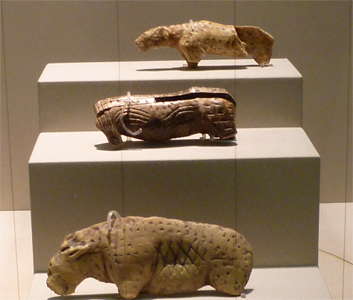
Animal sculptures
This gives a good idea of the relative sizes of these figurines.
Photo: Ralph Frenken
Source: Museum der Universität Tübingen
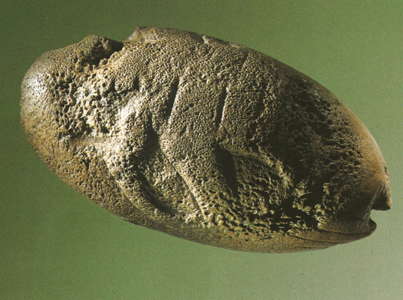
Bas relief of a mammoth, carved from bone.
Length 69 mm, height 29 mm, breadth 36 mm.
Photo: Müller-Beck et al. (1987)
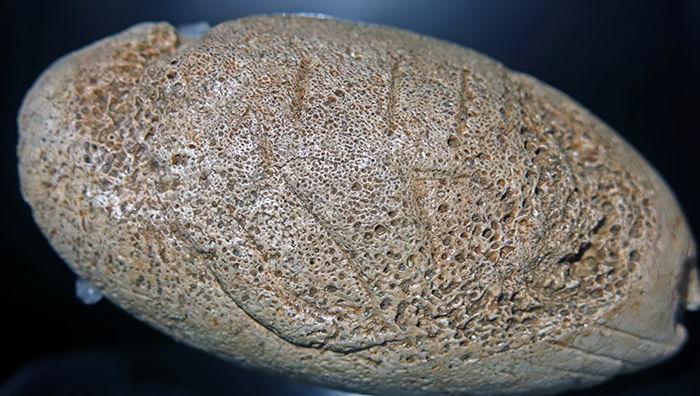
Mammoth carved in bone, exposing the spongiosa, circa 35 000 years old.
Photo: Don Hitchcock 2015
Source: Original, Museum der Universität Tübingen, Hohentübingen Castle
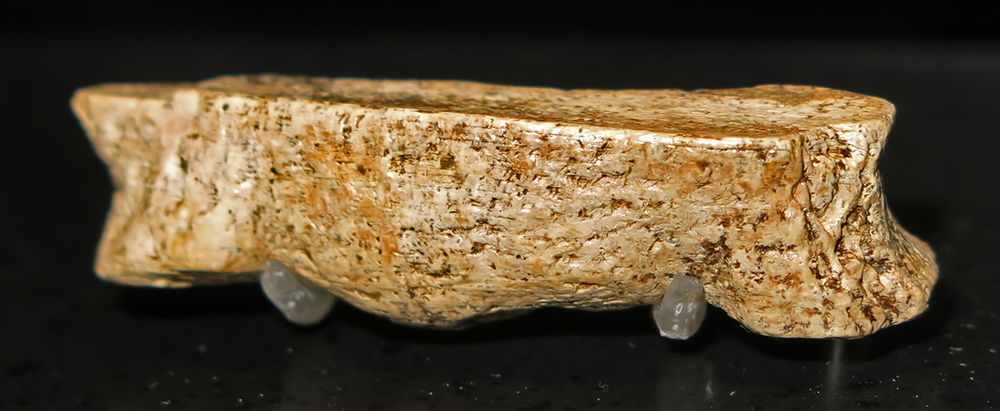
Part of an animal carved from mammoth ivory, the rest of the figure is yet to be found, circa 35 000 years old.
Photo: Don Hitchcock 2015
Source: Original, Museum der Universität Tübingen, Hohentübingen Castle
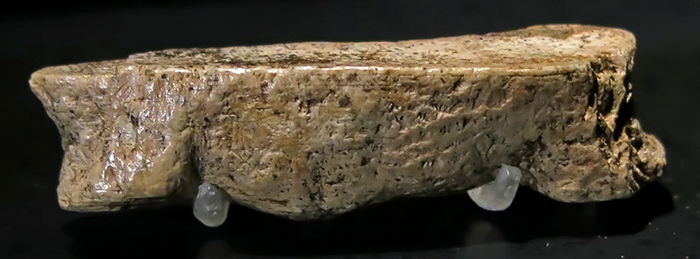
Part of an animal carved from mammoth ivory.
Photo: Don Hitchcock 2015
Source: Original, Museum der Universität Tübingen, Hohentübingen Castle
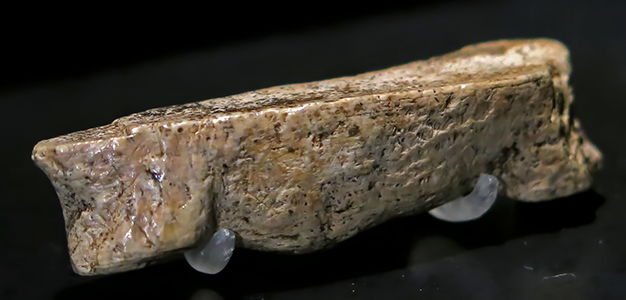
Part of an animal carved from mammoth ivory.
Photo: Don Hitchcock 2015
Source: Original, Museum der Universität Tübingen, Hohentübingen Castle
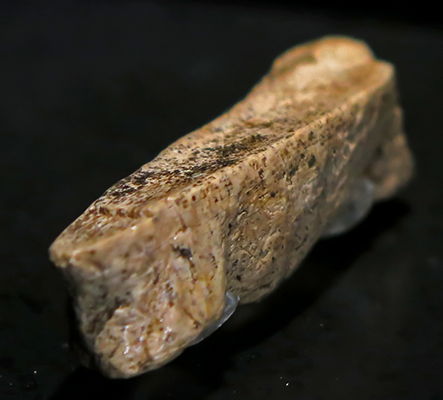
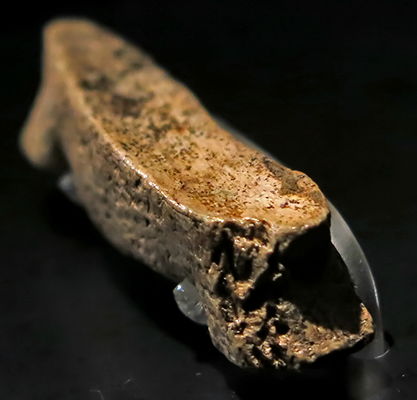
Part of an animal carved from mammoth ivory.
Photo: Don Hitchcock 2015
Source: Original, Museum der Universität Tübingen, Hohentübingen Castle
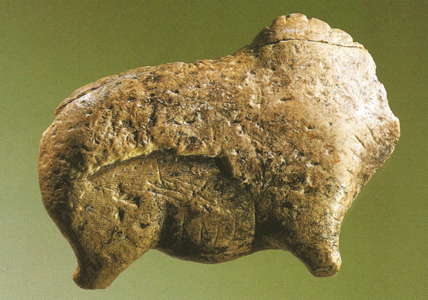
Bison.
Length 72 mm, height 52.5 mm, breadth 13.5 mm.
Photo: Müller-Beck et al. (1987)
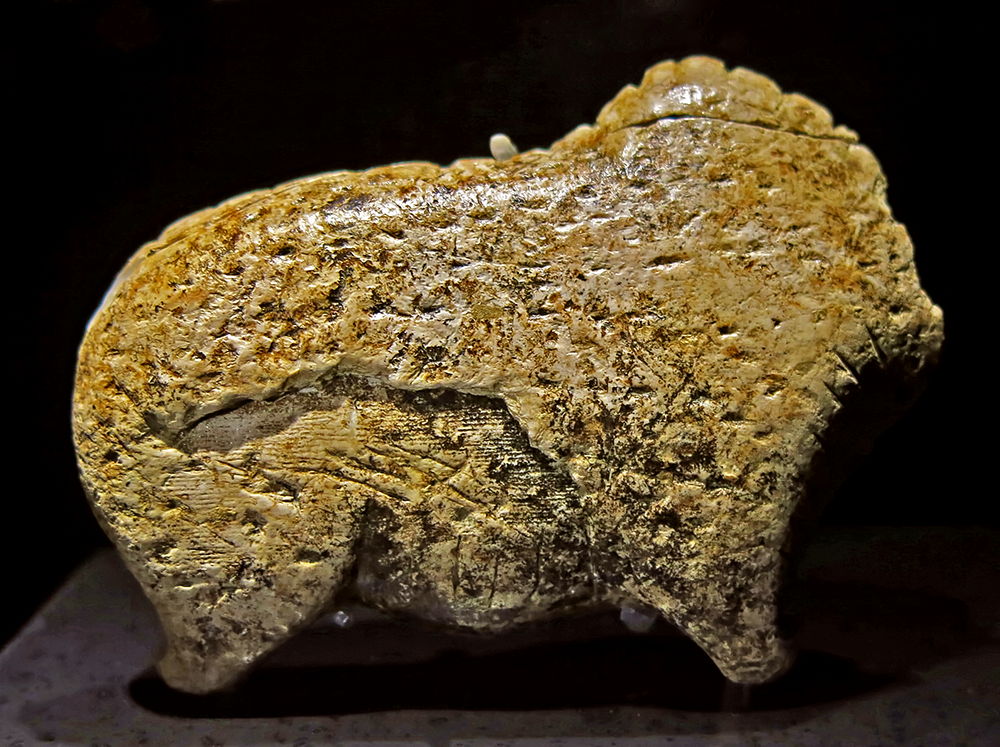
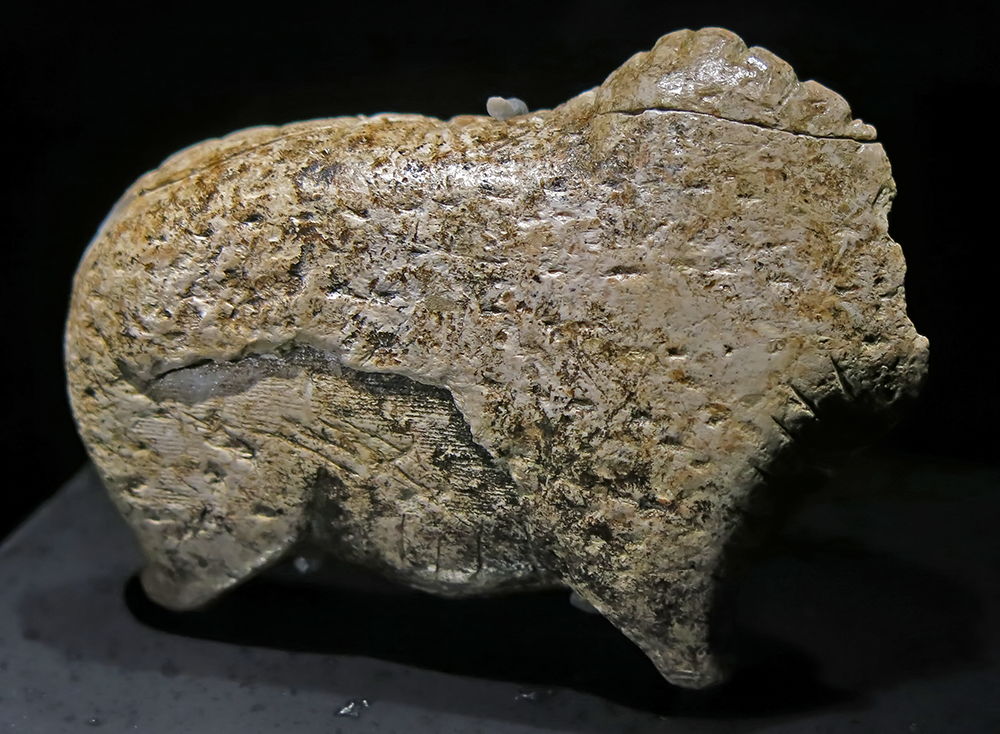
Bison
Photo: Don Hitchcock 2015
Source: Original, Museum der Universität Tübingen, Hohentübingen Castle
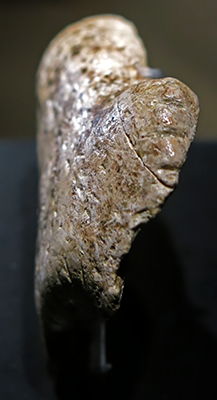
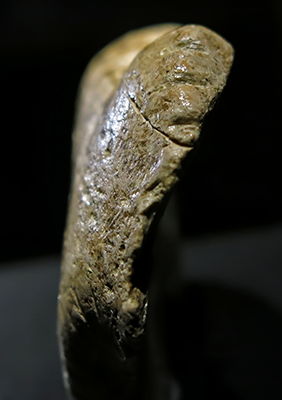
This closeup of the front of the bison figurine shows that the same segmentation decoration has been used on the head of the bison as on the back of the neck of one of the Cave Lion figurines.
In addition, as with so many of the Vogelherd figurines, the sculpture has been split in half lengthwise down the centre of the animal.
Photo: Don Hitchcock 2015
Source: Original, Museum der Universität Tübingen, Hohentübingen Castle
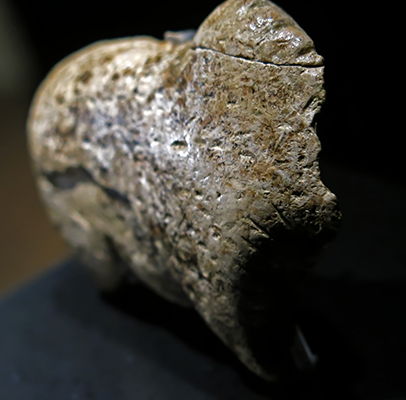
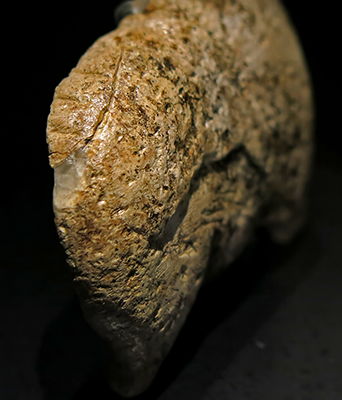
The segmentation decoration has been used on the rump of the animal, the back, the head and the throat. This style is in contrast to the method of decoration using crosses or a meshwork pattern.
Photo: Don Hitchcock 2015
Source: Original, Museum der Universität Tübingen, Hohentübingen Castle
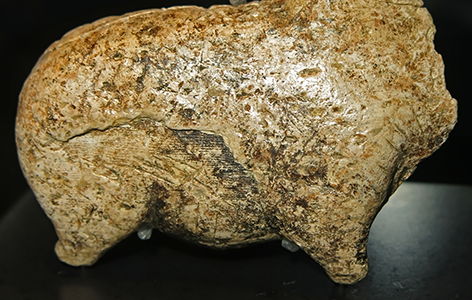

Closeups of the lower part of the bison figurine.
Here we can see clearly the natural striations created by the structure of the ivory when part of it has split off. This splitting appears to have happened in antiquity, judging from the patina on the striations feature, and the fact that some carving marks cut into the striations.
Photo: Don Hitchcock 2015
Source: Original, Museum der Universität Tübingen, Hohentübingen Castle
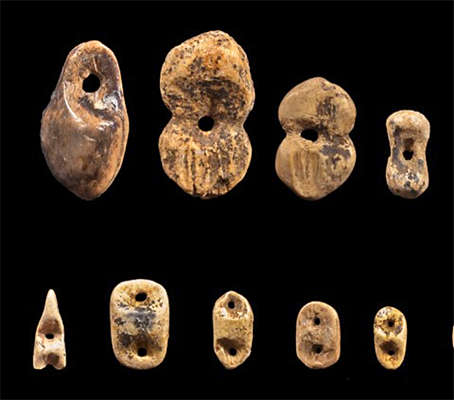
Jewellery found at the Vogelherd site.
Photo: http://www.archaeopark-vogelherd.de/einzigartige-funde
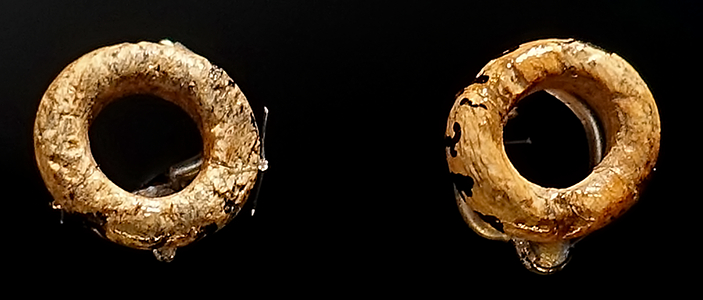
Two mammoth ivory rings, from the Vogelherdhöhle, Stetten ob Lontal, Niederstotzingen, Kreis Heidenheim.
Aurignacian, 40 000 BP - 35 000 BP.
Photo: Don Hitchcock 2018
Source and text: Landesmuseum Württemberg, Stuttgart
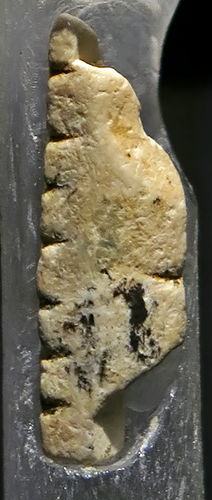
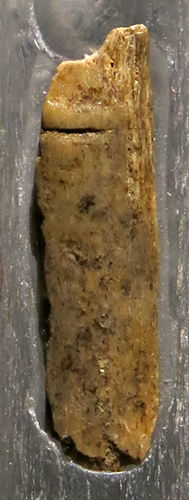
Flute fragments of bird bone and mammoth ivory from Vogelherd Cave, circa 35 000 years old.
Photo: Don Hitchcock 2015
Source: Original, Museum der Universität Tübingen, Hohentübingen Castle

Fragment of mammoth ivory bearing X marks, a common decoration from this site, circa 35 000 years old.
Photo: Don Hitchcock 2015
Source: Original, Museum der Universität Tübingen, Hohentübingen Castle

Fragment of mammoth ivory bearing transverse cuts, circa 35 000 years old.
Photo: Don Hitchcock 2015
Source: Original, Museum der Universität Tübingen, Hohentübingen Castle
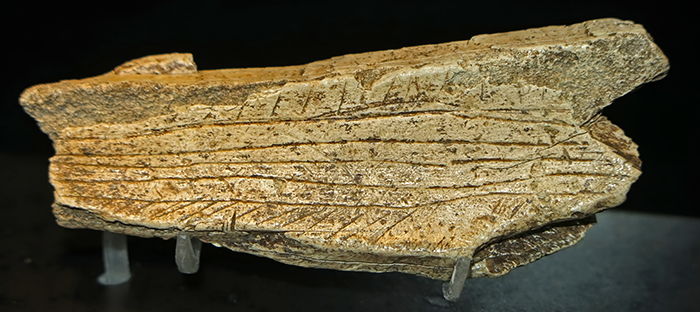
Fragment of mammoth ivory bearing longitudinal and oblique lines, circa 35 000 years old.
Photo: Don Hitchcock 2015
Source: Original, Museum der Universität Tübingen, Hohentübingen Castle
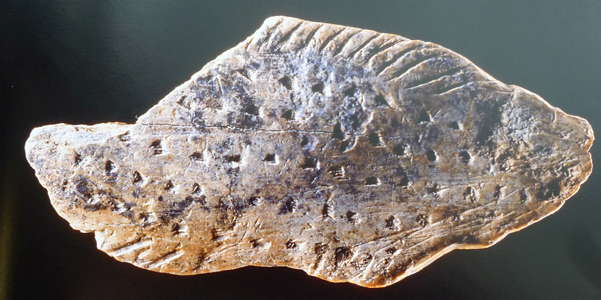
A new find from Vogelherd, depicting a fish.
Note also the distinctive decoration of small cupules, something which is very often used in the Vogelherd figurines.
Photo: Rau et al. (2009)

Three views of the fish, circa 35 000 years old.
Photo: Don Hitchcock 2015
Source: Original, Museum der Universität Tübingen, Hohentübingen Castle
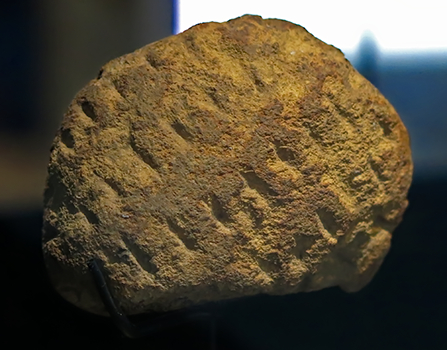
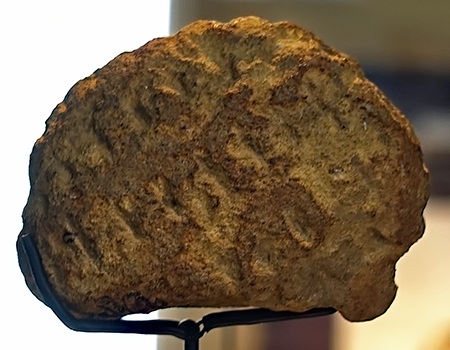
Mammoth.
Lime-sandstone, Vogelherdhöhle, Stetten ob Lontal, Niederstotzingen, Kreis Heidenheim.
From the Gravettian, 28 000 - 24 000 BP
Photo: Don Hitchcock 2015, 2018
Source and text: Landesmuseum Württemberg, Stuttgart
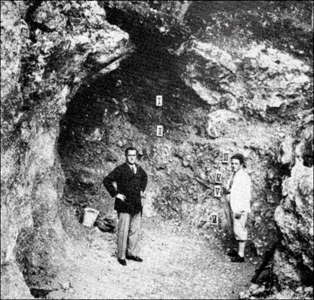
Gustav Riek (left) and an unknown person standing in front of the southwest entrance to Vogelherd at beginning of excavation in 1931.
Note tags in profile marking archaeological strata.
Photo and text: Conard et al. (2003)
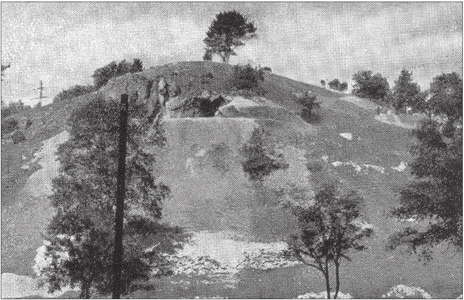
View of Vogelherd from the west. Visible are the Southwest entrance and on the right side of
photograph, the south entrance.
Photo after Riek (1934)
Text: Conard et al. (2003)
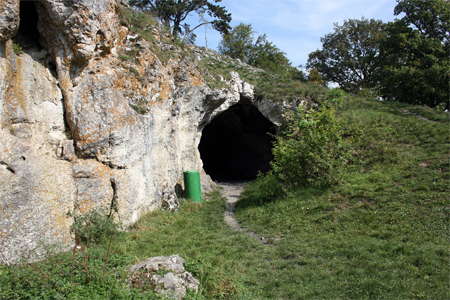
This is listed as the Western entrance of Vogelherd Cave on Wikipedia, though it is actually what is known as the Southwest entrance.
Photo: The Knife, 27th September 2011
Permission: This file is licensed under the Creative Commons license Attribution-Noncommercial-Share Alike 3.0 Unported license.
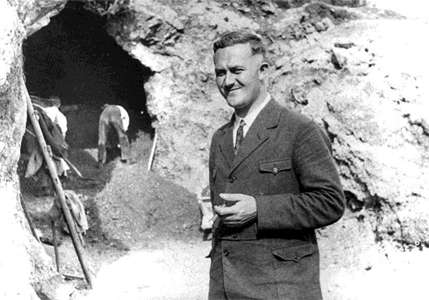
Gustav Riek in front of the southwest entrance to Vogelherd during excavation in 1931.
Photo: http://earth-chronicles.ru/news/2013-07-19-47253
(Note the suit, tie and cigar, supervising the workers as they toiled - oh, how excavations used to be run! - Don )
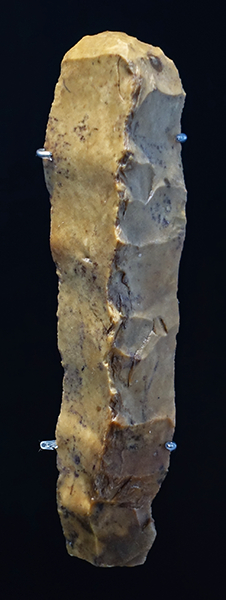
Grattoir, scraper on a blade, from Vogelherdhöhle, Stetten ob Lontal, Neiderstotzingen, Kreis Heidenheim, Magdalenian, circa 14 000 BP - 12 000 BP.
Photo: Don Hitchcock 2018
Source and text: Landesmuseum Württemberg, Stuttgart

Projectile point with wide base, bone, Vogelherdhöhle, Stetten ob Lontal, Niederstotzingen, Kreis Heidenheim, Aurignacian, circa 40 000 BP - 35 000 BP
Photo: Don Hitchcock 2018
Source and text: Landesmuseum Württemberg, Stuttgart

Typical tools, weapons and personal ornaments made of bone, antler and mammoth-ivory found at Vogelherd Cave. All artefacts are circa 35 000 years old.
Stone tools
1: blade core
2: Splintered piece
3: Quartz hammerstone
4: Nosed scraper
5: Carinated piece
6: Laterally retouched blade
7: Burin
8: Combination tool: scraper and blade
Tool made of bone
9: Smoother (Lissoir, used in preparing hides for use)
Weapons
10: Split based spear point (antler)
11: Split based spear point (antler)
12: Spear point with unsplit base (antler)
13: Decorated ivory spear point
14: Ivory spear point fragment with double bevelled base
Manufacture of beads and personal ornaments
15: Small ivory rod
16: Small ivory rod
17: Doubly perforated beads
Photo: Don Hitchcock 2015
Source: Original, Museum der Universität Tübingen, Hohentübingen Castle

1: blade core
2: Splintered piece
Photo: Don Hitchcock 2015
Source: Original, Museum der Universität Tübingen, Hohentübingen Castle
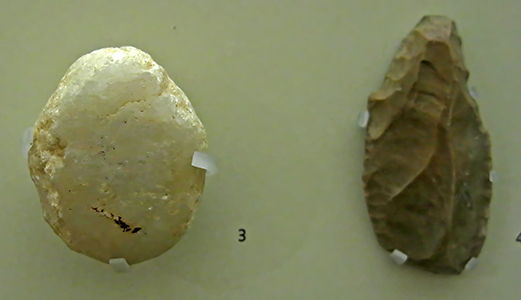
3: Quartz hammerstone
4: Nosed scraper
Photo: Don Hitchcock 2015
Source: Original, Museum der Universität Tübingen, Hohentübingen Castle
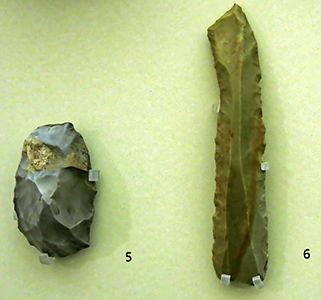
5: Carinated piece
6: Laterally retouched blade
Photo: Don Hitchcock 2015
Source: Original, Museum der Universität Tübingen, Hohentübingen Castle
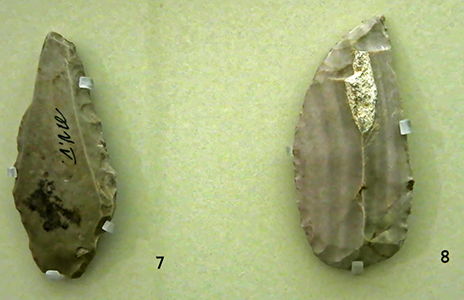
7: Burin
8: Combination tool: scraper and blade
Photo: Don Hitchcock 2015
Source: Original, Museum der Universität Tübingen, Hohentübingen Castle
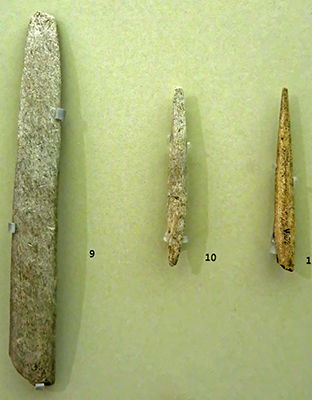
9: Smoother (Lissoir, used in preparing hides for use)
10: Split based spear point (antler)
11: Split based spear point (antler)
Photo: Don Hitchcock 2015
Source: Original, Museum der Universität Tübingen, Hohentübingen Castle
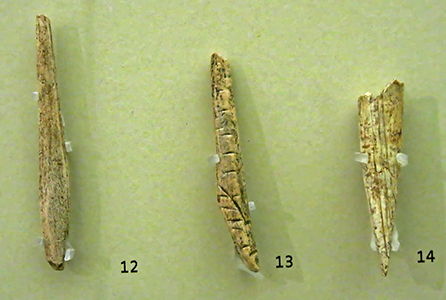
12: Spear point with unsplit base (antler)
13: Decorated ivory spear point
14: Ivory spear point fragment with double bevelled base
Photo: Don Hitchcock 2015
Source: Original, Museum der Universität Tübingen, Hohentübingen Castle
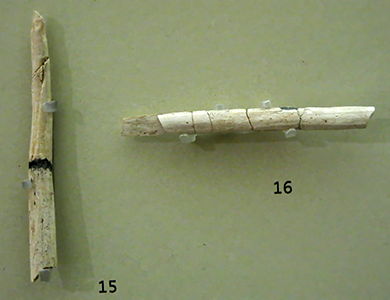
15: Small ivory rod
16: Small ivory rod
Photo: Don Hitchcock 2015
Source: Original, Museum der Universität Tübingen, Hohentübingen Castle
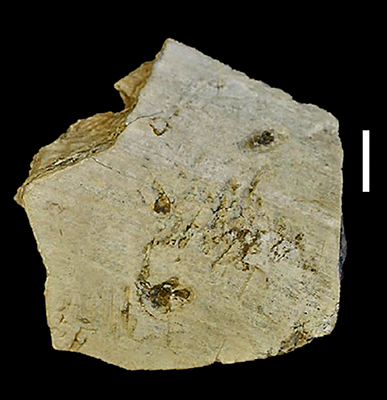
Retoucher of mammoth ivory, Vogelherd, Layer V, Aurignacian.
Photo and text: Toniato et al. (2018)
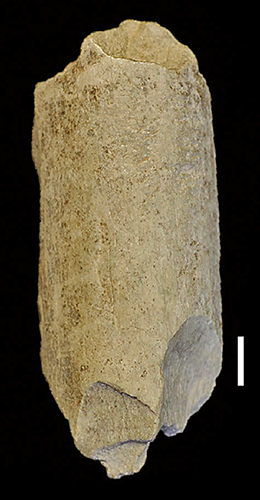
Retoucher using a long bone, Layer VII, Vogelherd, Middle Palaeolithic.
Photo and text: Toniato et al. (2018)
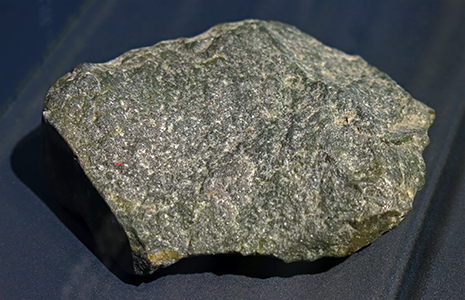
Geröllabschlag, pebble flake tool, Vogelherd, Niederstotzingen, circa 100 000 BP
Photo: Don Hitchcock 2015
On loan from Eberhard-Karls-Universität Tübingen
Source and text: Blaubeuren Museum
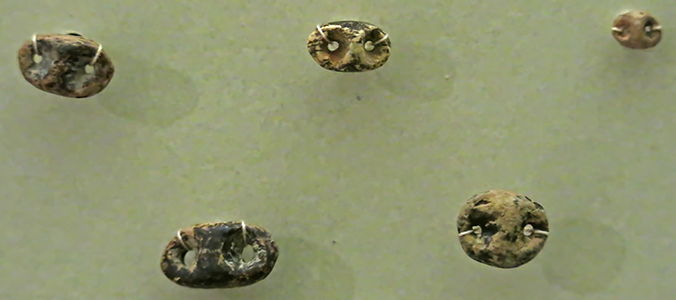
17: Doubly perforated beads
Photo: Don Hitchcock 2015
Source: Original, Museum der Universität Tübingen, Hohentübingen Castle
Thousands of bones of Ice Age animals have been discovered in the caves of the Swabian Jura. Their occurrence does not necessarily indicate that the animals were brought into the caves by people, because animals also used the caves as natural shelters. This point is particularly true for the remains of cave bears, which are common at sites throughout the Swabian Jura. Remains of mammoth are especially abundant during the Aurignacian. Bones of reindeer, horse and cattle are also well documented.
In the Stone Age no parts of these animals went to waste. They were exploited not only as a source of food, but also for their hides, bones and tendons, which were used for making clothing, shelter and many kinds of tools. At Vogelherd, archaeozoological studies have indicated that, although mammoth was occasionally hunted, the people of the Aurignacian must also have collected the ivory found in the cave from carcasses of animals that had died naturally.
Text above: Museum der Universität Tübingen, Hohentübingen Castle
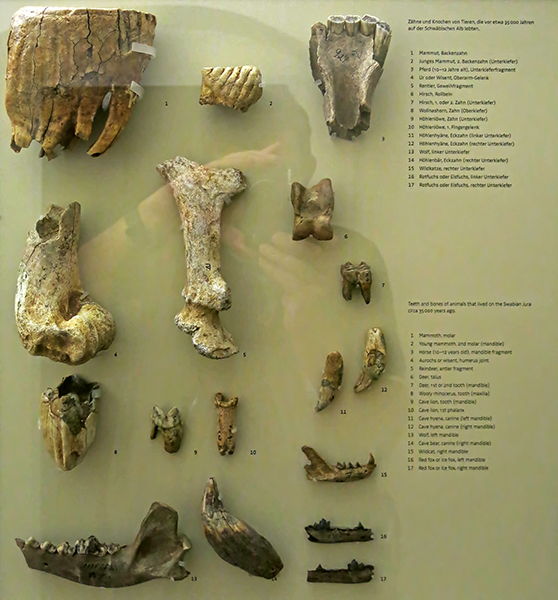
Animal remains from Vogelherd.
1: Mammoth, molar
2: Young mammoth, 2nd molar (mandible)
3: Horse (10-12 years old), mandible fragment
4: Aurochs or wisent, humerus joint
5: Reindeer, antler fragment
6: Deer, talus
7: Deer, 1st or 2nd tooth (mandible)
8: Wooly rhinoceros, tooth (maxilla)
9: Cave lion, tooth (mandible)
10: Cave lion, 1st phalanx
11: Cave hyena, canine (left mandible)
12: Cave hyena, canine (right mandible)
13: Wolf, left mandible
14: Cave bear, canine (right mandible)
15: Wildcat, right mandible
16: Red fox or arctic fox, left mandible
17: Red fox or arctic fox, right mandible
Photo: Don Hitchcock 2015
Source: Original, Museum der Universität Tübingen, Hohentübingen Castle
References
- Adam, K., Kurz, R., 1980: Eiszeitkunst im süddeutschen Raum, Theiss.
- Boger, U., Starkovich, B., Conard N., 2014: New insights gained from the faunal material recovered during the latest excavations at Vogelherd Cave, Mitteilungen der Gesellschaft für Urgeschichte Volume: 23
- Conard, N., Niven L., Mueller K., Stuart A., 2003: The Chronostratigraphy of the Upper Paleolithic Deposits at Vogelherd, Mitteilungen der Gesellschaft für Urgeschichte, — 12 (2003) 73
- Cook, J., 2013: Ice Age art: arrival of the modern mind, The British Museum, 18 Feb 2013, ISBN-10: 0714123331, ISBN-13: 978-0714123332
- Delporte H., 1993: L’image de la femme dans l’art préhistorique, Éd. Picard (1993)
- Müller-Beck, H. and Albrecht, G. (Ed.), 1987: Die Anfänge der Kunst vor 30000 Jahren Theiss: Stuttgart.
- Niven L., 2003: The role of mammoths in Upper Palaeolithic economies of southern Germany, In: J. Zilhão, F. d’Errico (Eds), The Chronology of the Aurignacian and of the Transitional Technocomplexes: Dating, Stratigraphies, Cultural Implications.Trabalhos de Arqueologia 33: 199-211.
- Pushkina D., 2007: The Pleistocene easternmost distribution in Eurasia of the species associated with the Eemian Paleooloxodon antiquus assemblage, Mammal Rev. 2007, Volume 37, No. 3, 224-245.
- Rau, S., Naumann D., Barth M., Mühleis Y., Bleckmann C., 2009: Eiszeit: Kunst und Kultur, Thorbecke, 2009, 396p. ISBN: 978-3-7995-0833-9
- Riek, G., 1934: Die Eiszeitjägerstation am Vogelherd im Lontal, Tübingen: Akademische Buchhandlung Franz F. Heine.
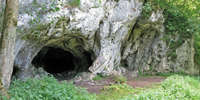 This link takes the reader to the in depth discussion of the Vogelherd cave itself, as well as the other Lonetal Sites, including Neanderthal and Middle Paleolithic sites in the Swabian Alb near the city of Ulm, which were important areas of ice age art. The sites occur in the Schwaebische Alb (Swabian Alb), in the valleys of the Ach and Blau river near Blaubeuren, where the famous lion/human figure was found in the Hohlenstein-Stadel cave, and where the superb sculptures from Vogelherd were discovered.
This link takes the reader to the in depth discussion of the Vogelherd cave itself, as well as the other Lonetal Sites, including Neanderthal and Middle Paleolithic sites in the Swabian Alb near the city of Ulm, which were important areas of ice age art. The sites occur in the Schwaebische Alb (Swabian Alb), in the valleys of the Ach and Blau river near Blaubeuren, where the famous lion/human figure was found in the Hohlenstein-Stadel cave, and where the superb sculptures from Vogelherd were discovered. 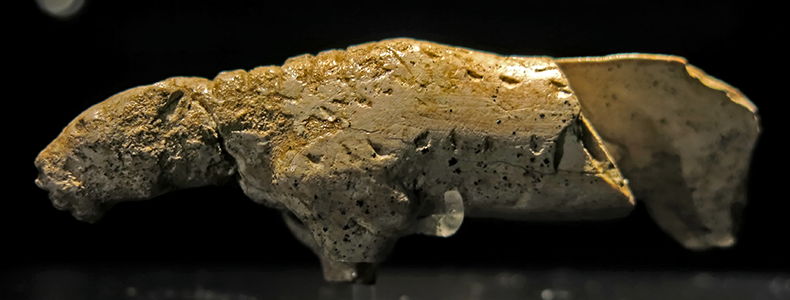
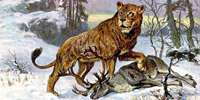 The cave lion is known from Paleolithic cave paintings, ivory carvings, and clay figurines. These representations indicate that cave lions had rounded, protruding ears, tufted tails, possibly faint tiger-like stripes, and that at least some had a ruff or primitive mane around their neck, indicating males. The cave lion received its common name because large quantities of its remains are found in caves, but it is doubtful whether they lived in them. They probably preferred conifer forests and grasslands, where medium-sized to large herbivores occurred.
The cave lion is known from Paleolithic cave paintings, ivory carvings, and clay figurines. These representations indicate that cave lions had rounded, protruding ears, tufted tails, possibly faint tiger-like stripes, and that at least some had a ruff or primitive mane around their neck, indicating males. The cave lion received its common name because large quantities of its remains are found in caves, but it is doubtful whether they lived in them. They probably preferred conifer forests and grasslands, where medium-sized to large herbivores occurred.